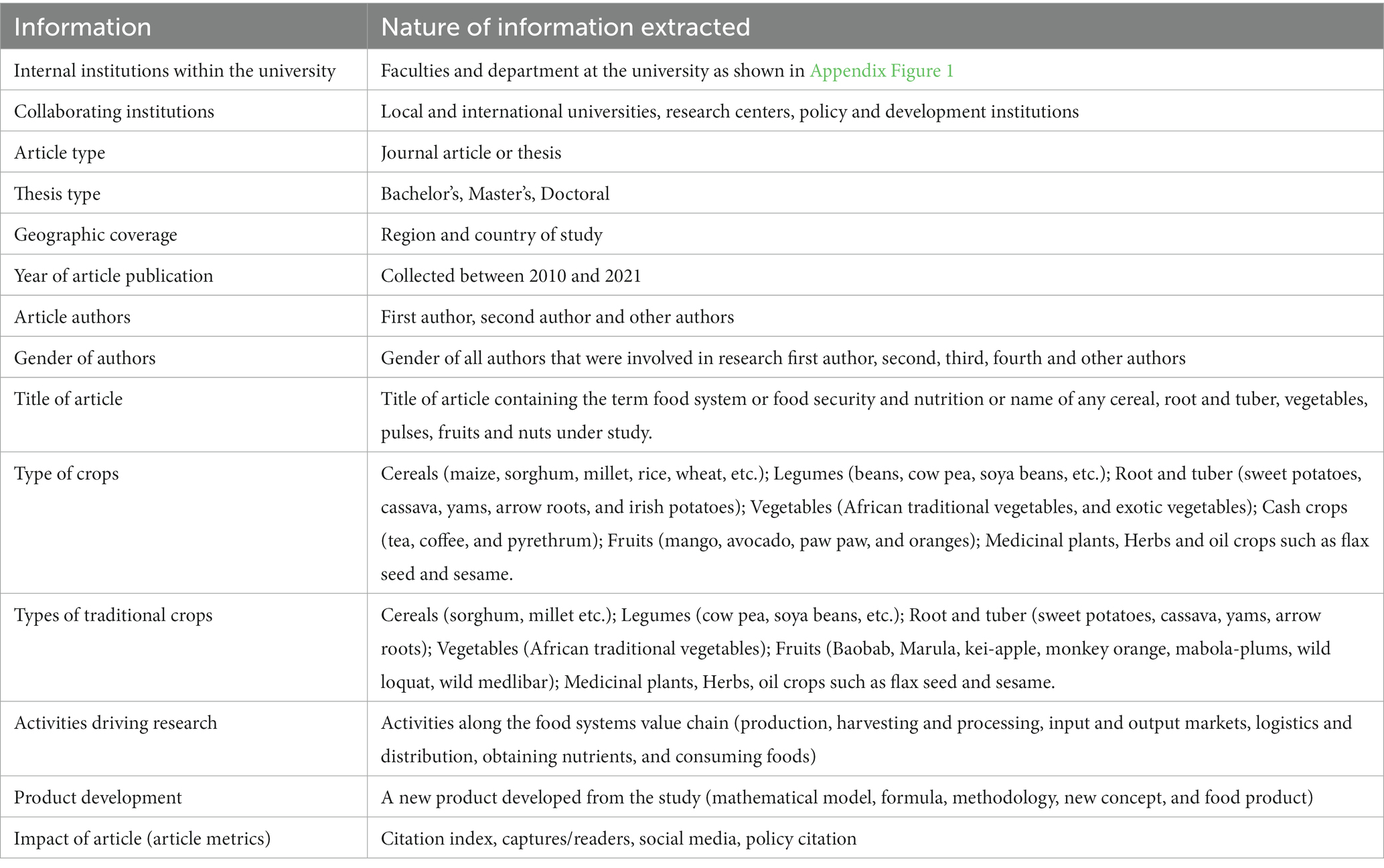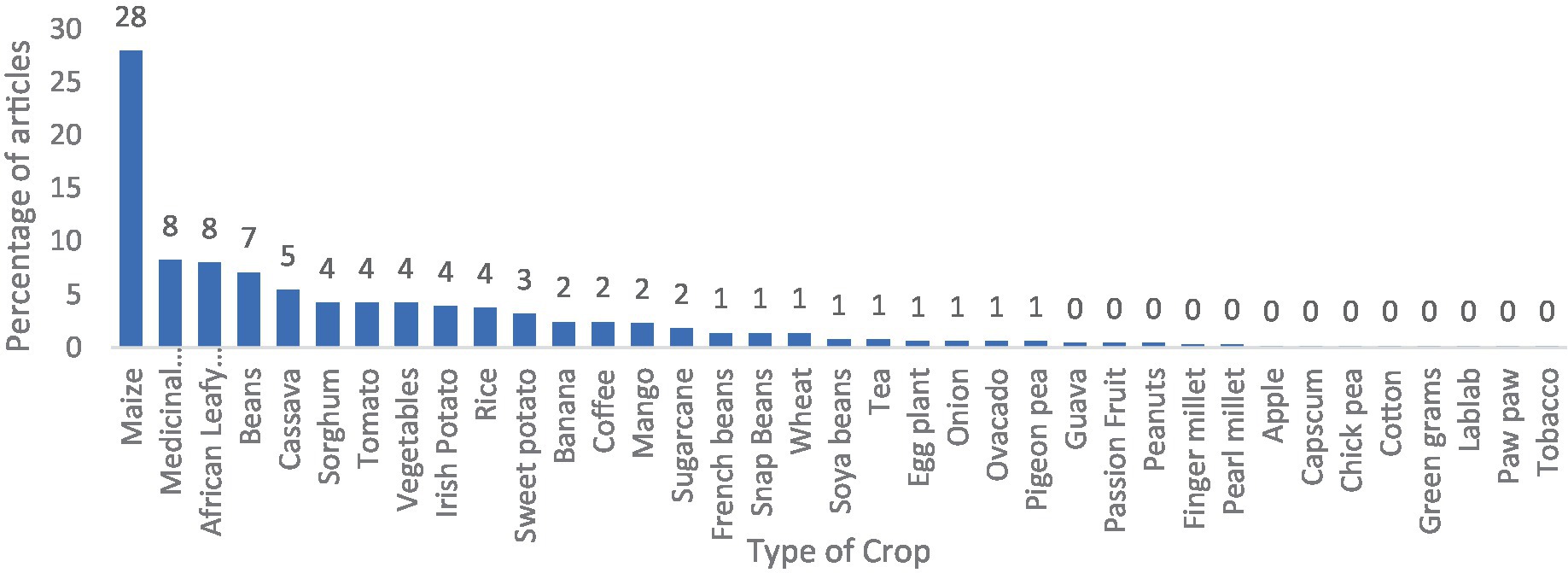- 1African Research Universities Alliance Centre of Excellence in Sustainable Food Systems, University of Pretoria, Pretoria, South Africa
- 2Department of Plant and Soil Science, University of Pretoria, Pretoria, South Africa
- 3Department of Plant Science and Crop Protection, University of Nairobi, Nairobi, Kenya
- 4Department of Land Resource Management and Agricultural Technology, University of Nairobi, Nairobi, Kenya
- 5Department of Animal Science, University of Nairobi, Nairobi, Kenya
- 6Department of Agricultural Economics, University of Nairobi, Nairobi, Kenya
- 7Office of the Sustainable Food Systems Research Chair, Future Africa, University of Pretoria, Pretoria, South Africa
- 8Department of Animal Science, Faculty of Natural and Agricultural Sciences, University of Pretoria, Pretoria, South Africa
Research conducted on food systems by higher institutions can contribute to sustainable food security and nutrition at a local level and reduce the impact of societal challenges such as malnutrition. Unfortunately, malnutrition itself manifests as hidden hunger causing unintended consequences such as illness negatively affecting economic progress. Traditionally, research in agriculture has not taken a food systems approach which is looking at challenges of food systems from farm to fork (all stages from production to consumption). Therefore, as we embrace the compelling call to transition from agriculture to food systems research approaches, mapping studies at a local level are needed. However, studies on food systems have been carried out at a macro (global or regional level), a micro-perspective investigation is needed to inform future research. A systematic review on existing literature (journals and thesis) was conducted to identify gaps and opportunities in research on food systems undertaken by researchers at the University of Nairobi. Information collected included; 1. institutions (faculties and department at the university, national policy, and international institutions collaborating with university of Nairobi), 2. crop types (cereals, legumes, vegetables, roots and tubers, and nuts), 3. food systems activities (production, postharvest, processing, and preservation, value addition and branding, consuming foods, input and output markets, obtaining nutrients as well as logistics and distribution) driving research on food systems. The contribution of each of the components (institutions, food systems activity and crop type) was also investigated through citation scores. The findings show that low research outputs on food systems were generated by the university of Nairobi compared to selected universities in Africa and across the globe. Research was focused on carbohydrate rich crops (maize, sorghum, cassava, irish potato, sweet potato, and rice) as compared to protective bioactive vitamin crops (vegetables, mango, and beans). This demonstrated low crop diversity and dietary quality. Research priority was given mainly to maize compared to traditional crops such as sorghum, African Leafy Vegetables, cassava and millets. Faculties such as health, science and technology, engineering, and humanities were involved in research in food systems in addition to agriculture, a potential indication of transdisciplinary research. Additionally, there was more collaborative research between university of Nairobi with institutions at a global level than with local institutions. The involvement of policy institutions in research was low, mainly restricted to the discipline of agriculture, production food system activity and in a few crops such as maize, cassava, and medicinal plants. Disparities in research existed along the food systems activities as more attention was focused on production activities. Other food system activities such as harvesting, processing and preservation, consumption, value addition and branding, input and output markets, as well as logistics and distribution activities, received low research priority. Each component (food system activity, crop type and institution) demonstrated contribution to sustainable food security as shown by citation scores. The findings demonstrate skewed focus in food systems research at the university of Nairobi. Agricultural research investment within institutions of higher learning will need to consider all food systems activities, under-researched crops and collaborations that advance transdisciplinary studies to promote inclusive contribution of food systems to food security at a local level. Further studies can focus on developing frameworks to advance transdisciplinary research.
Background information
Recent developments in agricultural research have seen improvements in crop productivity and a reduction in food loss and waste (Valoppi et al., 2021). Despite these improvements, societal problems manifested as malnutrition, hidden hunger and obesity continue to plague the world (IPBES, 2019). These problems are highly felt in Sub-Saharan Africa. Currently, the prevalence of malnutrition cases in Sub-Saharan Africa stands at 29% compared to a global estimate of 21% (UNICEF, 2020). Climate change, dwindling natural resources and emerging pandemics will likely exacerbate these problems. An estimated 100 million people in Africa faced a crisis, emergency, or catastrophic levels of food insecurity in 2021 (Rwamasirabo, 2021; Sibanda and Mwamakamba, 2021). This number is expected to grow as a further 20 million more people will soon join the number because of the effects of the COVID-19 pandemic (Rwamasirabo, 2021; Sibanda and Mwamakamba, 2021). There is an urgent need for research to deliver sustainable solutions to these problems and also ensure food security and nutrition to the increasing human population which is expected to rise to 9 billion people by 2050, especially in Sub-Saharan where much of the population increase will likely occur.
The recent discourse in research has revolved around the application of food systems to enhance sustainable food security and nutrition (Ruben et al., 2019; Dekeyser et al., 2020; Borman et al., 2022). A key characteristic of food systems is the extensive linkages and interdependencies between components within the system. This implies that all the components along the food systems value chain involving growing and harvesting agricultural products, processing, packaging, transporting, selling, consuming, and the disposal of waste food and packaging are included (Benton and Thompson, 2016). Food systems help determine efficiency and identify externalities, shocks, and hotspots that require interventions (Alarcon et al., 2021). The study of food systems involves an analysis of components, linkages, activities, and factors (Von Braun et al., 2021). Food systems analysis can therefore assist in understanding food security and nutrition challenges, shaping research and policy, and providing strategic interventions to help solve societal challenges at a global, regional, national, and local level (Borman et al., 2022). However, food systems analysis is yet to provide solutions to these challenges. This is because studies on food systems have focused mainly on a particular activity along the food system, e.g., production (Duressa, 2018; Holka and Bieńkowski, 2020; Cairns et al., 2021) or processing and packaging (Okech et al., 2016; Beinah and Kunyanga, 2020; Malavi et al., 2021) and on addressing a single problem. An inclusive analysis of all components in a food system is needed to enhance the benefits.
Food systems research on under-utilized traditional or indigenous crops can positively contribute to sustainable food security and nutrition owing to the numerous nutritional benefits of the crops. Traditional are crops that were introduced a long time ago and have been naturalized in certain geographic regions (Akinola et al., 2021). Indigenous are crops that have origin within a certain geographic region and are not defined by a set of time (Akinola et al., 2021). Traditional or indigenous terms are synonymously used in literature to include crops such as sorghum (Sorghum bicolor), pearl millet (Pennisetum glaucum), cassava (Manihot esculenta), sweet potatoes (Ipomoea batatas), nightshades (Solanum spp), marula (Sclerocarya birrea), and Bambara groundnut (Vigna subterranean), among others. The crops have dense macro- and micronutrients content (Mibei et al., 2016; Ngugi et al., 2016; Ontita et al., 2016; Ali et al., 2021); can effectively provide solutions to the double malnutrition challenge experienced on the African continent, and proponents have recommended the need to intensify research on traditional crops. However, research has put more focus on crops such as maize, wheat and rice (Mondo et al., 2018; Mwizerwa et al., 2018; Gitari et al., 2019; Odingo, 2019; Owade et al., 2019; Ichami et al., 2020; Jekayinoluwa et al., 2020; Mukami et al., 2020; Malavi et al., 2021; Wagaba et al., 2021). As a result, many of the traditional food crops remain undocumented, and the few documented crops have not been exploited sufficiently to attain their full potential considering all the activities along the food system value chain (Sibanda and Mwamakamba, 2021). This has resulted in low consumption and marketability of these crops. The low consumption of traditional crops has been attributed to factors such as household annual income, household size, farm size, culture, gender, and employment status (Kathure et al., 2019). The high marketability value of traditional crops is yet to enhance income and improve livelihoods. Marketing data shows that few farmers participate in commercialization of indigenous crops. A study by Zondi et al. (2022) shows that 20% of farmers producing traditional crops in South Africa participate in marketing of these crops. Similarly, only 20% of farmers are reported to participate in marketing of traditional crops in Kenya, Mozambique and Malawi (Moyo et al., 2022). This can be attributed to several factors such as a lack of market information, gender, off-farm income and weak value chain linkages (Zondi et al., 2022). Institutional involvement, especially at the local level, in research on traditional crops can promote production, commercialization and utilization of these crops (Lugo-Morin, 2020; Makate, 2020). However, institutional involvement in the promotion of traditional crops is low. Within the African continent, the Africa Vegetable Breeding Consortium (AVBC) established by the World Vegetable Center is involved in promoting the production of traditional crops such as Amaranthus (Ochieng et al., 2019). Within the southern and central parts of Africa, the Diversity International’s African Leafy Vegetable program conducted in Botswana, Cameroon, Kenya, Senegal, and Zimbabwe has promoted the breeding and production of seed (Ruth et al., 2021). The South African Department of Agriculture, Forestry and Fisheries (DAFF) has developed a National Strategy on Indigenous Food Crops to support research and technology development of these crops (DAFF, 2011). In Eastern Africa, the East Africa Seed Company, World Vegetable Center, University of Nairobi, Jomo Kenyatta University of Agriculture and Technology (JKUAT) and Kenya Agricultural and Livestock Research Organization (KALRO) are involved in promoting the production and commercialization of traditional crops (Ochieng et al., 2019). Inclusion of these crops in food systems in addition to maize, rice, and wheat can contribute to sustainable food security.
Rethinking and reinventing research and development interventions in food systems using new approaches such as transdisciplinary could also contribute to food security and nutrition (Alarcon et al., 2021). Transdisciplinary is a participatory research approach where participants from science and society work closely together to identify challenges to complex societal problems (Berger-González et al., 2016). The core tenet of transdisciplinary research is its focus on shared problems and the active input of different practitioners as different goals and ambitions are simultaneously pursued (Clancy, 2017). Multiple stakeholders from science and non-science fields within a wide range of disciplines are involved which leads to better feedback and linkages of research to policy and practice (Pineo et al., 2021). Transdisciplinary research is increasingly being used in the health field to solve complex problems (Arenas-Monreal et al., 2015; Berger-González et al., 2016; Chastin et al., 2016; Fam, 2016; Black et al., 2019; Pineo et al., 2021; Ilangovan et al., 2022). The application of transdisciplinary research in food systems is yet to gain traction as only a few studies exist with collaboration across different disciplines (Claasen and Lemke, 2015; Kimondo et al., 2015; Kariuki et al., 2018).
It is against this backdrop, that research and development interventions in food systems need to be inclusive, integrate under-researched crops, and apply transdisciplinary approaches to enhance food security and nutrition. More important is for institutions, such as universities, conducting studies on food systems to understand priority areas of research and development (Committee on World Food Security, 2017). Universities are an important component of research as they are endowed with human resources, infrastructure and research funds (Lancho-Barrantes and Cantu-Ortiz, 2021). They also carry out capacity development, are sources of innovation, and take part in knowledge transfer. They have the capacity to undertake research and provide solutions toward sustainable food systems. However, mapping studies on food systems to identify gaps and opportunities that can play a significant role in providing direction, within local institutions such as universities, are largely missing (Alarcon et al., 2021). More often, studies on food systems mapping are available at a macro (global and regional level) (Valoppi et al., 2021; Bokelmann et al., 2022; Woodhill et al., 2022), hence a micro perspective investigation is needed to inform research and development priorities in food systems. Micro in this context refers to internal units (departments and faculties) and external organizations collaborating in research within an institution.
The study undertook a micro-institutional mapping exercise on research on food systems at the University of Nairobi (UoN). The main objective of the study was to map the studies that have been carried out on food systems at the UoN and identify gaps as well as opportunities for future research. The specific objectives were to use studies published by the UoN to; 1. map institutions undertaking research on food systems, 2. identify activities driving research on food systems, 3. identify crop types driving research on food systems, and 4. quantify the impact of studies on food systems on sustainable food security and nutrition (number citations, visibility, policy citations, reads, and social media mentions).
Materials and methods
The study institution
Within the East African region, Kenya was considered for benchmarking research outputs on food systems due to research performance and economic growth. The research performance broadly represents the status of research within East Africa. A mapping exercise was conducted at the University of Nairobi (UoN), Kenya, to identify studies on food systems. The university ranks the highest in research and capacity development in Kenya according to the Times Higher Education (THE) (Hongbo et al., 2021) and has higher research outputs produced compared to other institutions in the country. The research outputs broadly represent the research status on food systems in Kenya. The UoN comprises six colleges located across Nairobi city. The colleges include; the Colleges of Agriculture and Veterinary Sciences, Architecture and Engineering, Biological and Physical Sciences, Education and External Studies, Health Sciences, and Humanities and Social Sciences. The organogram for the UoN is shown in Appendix 1. These colleges uniquely place the university as a core institution to advance research in food systems. With more investment in research, it is important that the university responds to the challenges of food security and nutrition by delivering research that encompasses solutions from a wide range of disciplines.
Benchmarking research output
The research outputs collected were the number of publications. The study adopted and customized the systematic review process guided by the Preferred Reporting Items for Systematic Reviews and Meta-Analyzes (PRISMA) method as shown in Figure 1 (Tawfik et al., 2019). The PRISMA is a robust method that ensures the transparent and complete reporting of systematic reviews and meta-analyzes and has mostly been applied in the health sciences (Liberati et al., 2009). The method has four key stages which include; identification, screening, eligibility, and inclusion (Liberati et al., 2009).
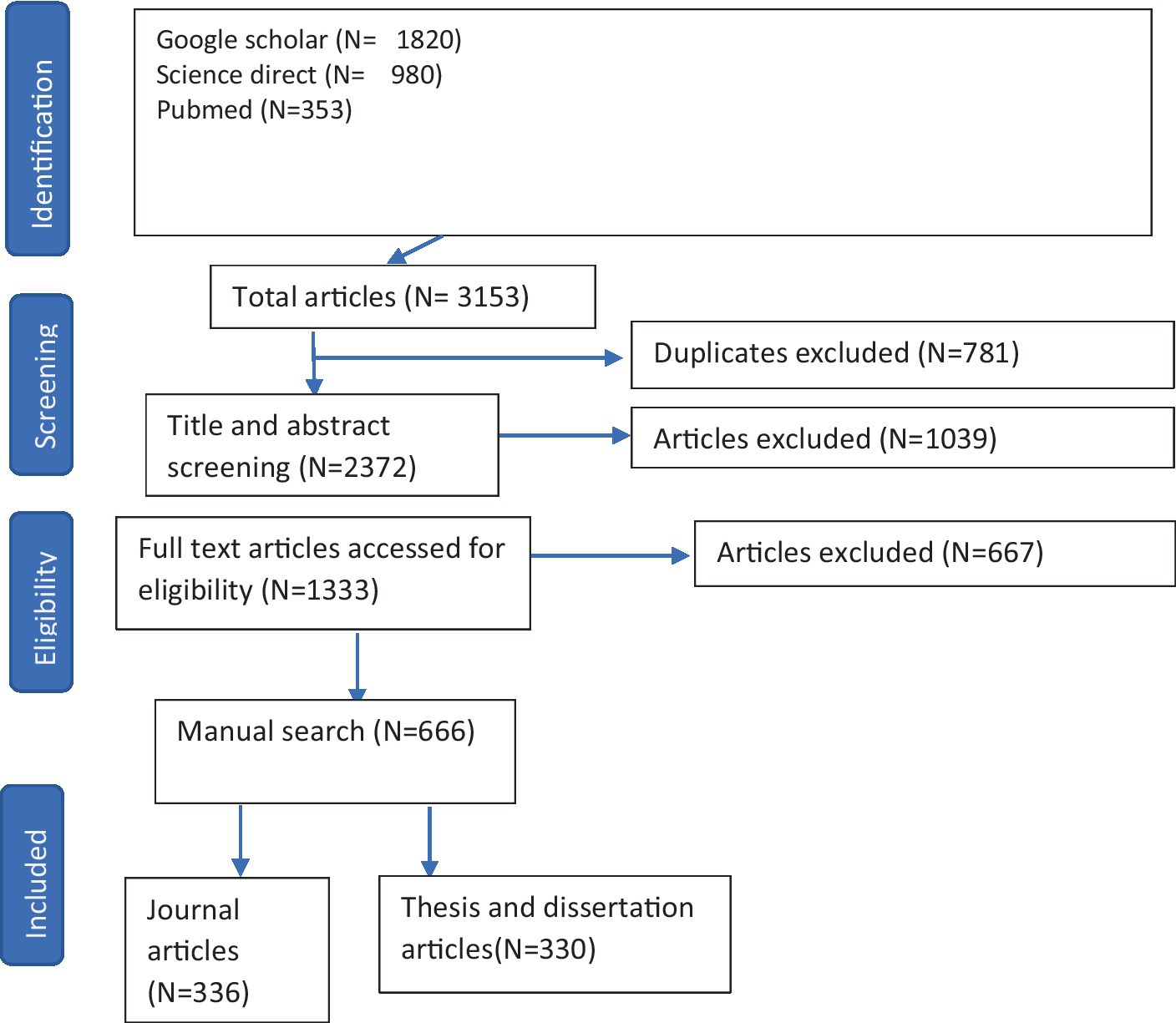
Figure 1. The Preferred Reporting Items for Systematic Reviews and Meta-Analyzes (PRISMA) showing the identification, screening, eligibility and inclusion process for the articles. Source; (Tawfik et al., 2019).
The identification stage involved a preliminary search of articles contained in the PubMed, Science Direct, and Google Scholar databases focusing on food systems. According to PRISMA guidelines articles included in the study should have themes that are of global relevance (Tawfik et al., 2019). The terms “food system,” “food security,” and “nutrition” were included in the initial identification stage to ensure the selected articles focused on global needs. The search string used was to improve the search criteria and included the relevant articles, the descriptors “AND,” “OR” and specific food systems crops such as “maize,” “beans,” “millet,” and “finger millet,” among others. The screening of articles was performed using titles and abstracts. During the screening phase, full articles were downloaded and the abstracts and titles of the articles were reviewed to identify; the context of the study, objectives, authors, type of food systems studied, geographic coverage, and activities driving food systems. Duplicate articles were removed.
The eligibility phase included defining the inclusion and exclusion criteria. The inclusion criteria were; research articles on food systems conducted between 2010 and 2021, articles having geographic coverage within Africa, and online articles under the UoN repository. All crops were included in the study to help understand the trends in research on traditional crops versus other crops. The search was then narrowed down to the UoN repository. A manual search to select research studies on crops was performed. Theses and dissertation articles were included. Abstract-only articles and pay-to-access journals were excluded.
Formulating the research questions
Formulation of the research questions was guided by the Food Systems Research Network for Africa (FSNet-Africa) Framework (FSNET, 2021; Figure 2). The FSNet framework comprises many components among them the drivers, actors, institutions, food systems components, and food systems outcomes/impacts (Figure 1). The framework was used because of its ability to capture multi-dimensional aspects along the food systems value chain. In this context, the framework was used to describe and identify activities driving research on food systems at the UoN. These activities included; input and output markets, logistics and production, innovation and branding, production and processing, consuming food, and obtaining nutrients. The actors and the institutions involved in research studies on food systems were also identified. The research questions are shown in text Box 1. Actors are the activities, the people and other organisms involved in the food chain. Institutions in this case are both internal (faculties and departments) and external organizations collaborating in research with university of Nairobi (international universities, research centers, national policy and national universities).
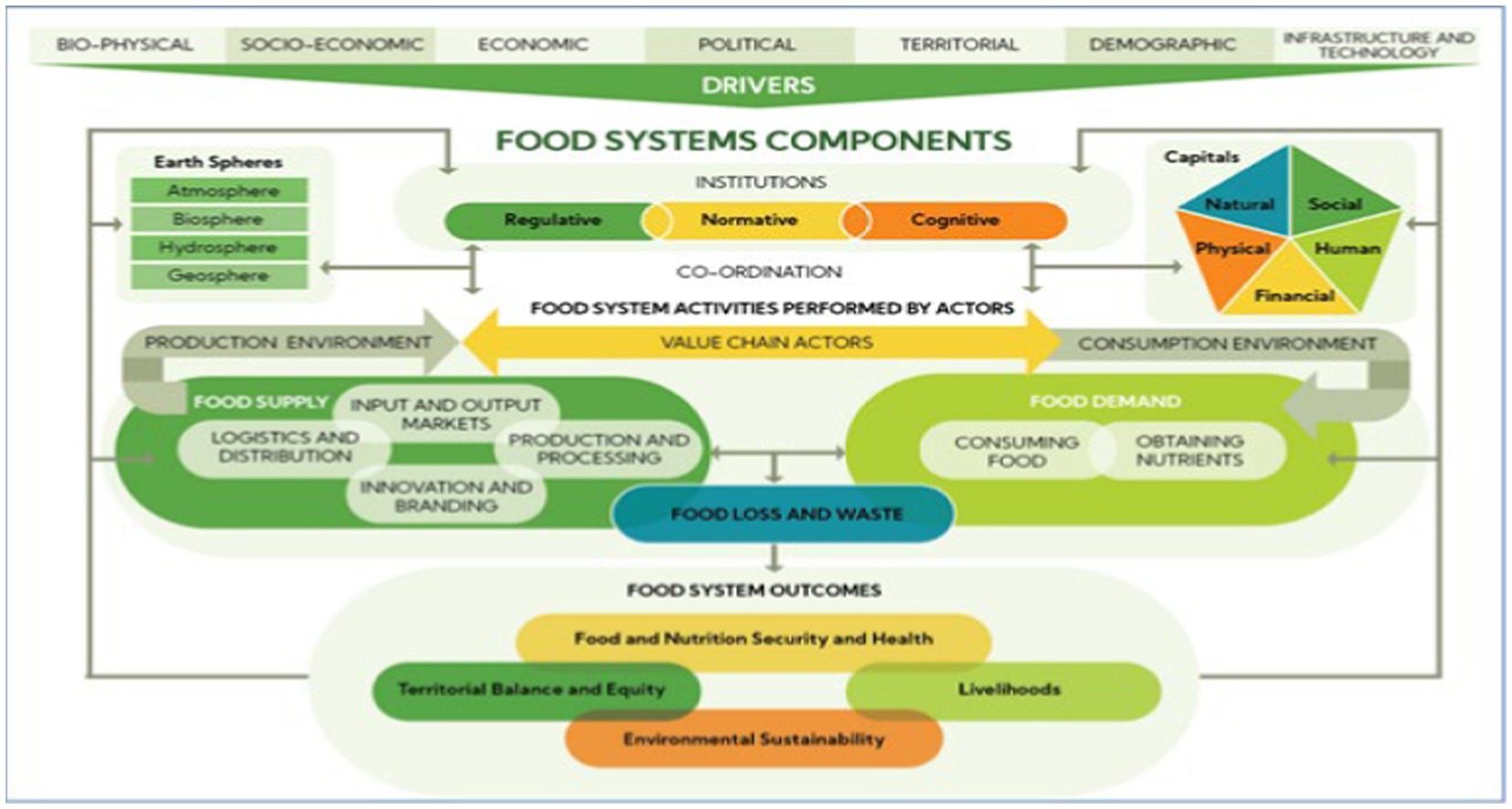
Figure 2. The conceptual framework guiding formulation of research questions. Source; (FSNET, 2021).
Box 1. Research questions guiding the study
The following research questions were used to identify departments, faculties, institutions, and actors involved in research on food systems.
• Which departments/faculties/research centers/units are driving food systems related research?
• Which departments/faculties/research centers/units are collaborating in research studies on food systems?
• Which external institutions (policy, universities, research centers) are involved in research on food systems?
• Which departments/faculties/research centers/units at UoN have the potential to drive the agenda of Sustainable food systems even though they may not have done research in that area?
• Which activities (production and processing, innovation and branding, food loss and waste, consuming foods, obtaining nutrients) are driving research on food systems?
• How is research on food systems at UoN contributing toward sustainable food systems locally, nationally, and globally?
Data extraction
After identifying the eligible articles, a systematic review process for every article was conducted. Themes were delineated using the abductive method (Conaty, 2021). The information shown in Table 1 was extracted.
Data analysis
The data were entered into an Excel spreadsheet, coded and exported to STATA software for analysis. Descriptive statistics were obtained to summarize the collected data. Regression models were constructed to analyze the effect of the collected variables on the contribution of research studies on food systems toward sustainable food security and nutrition. According to Ebrahim et al. (2014), the citation score is a measures of research impact. The citation scores were collected from three search engines namely, Google Scholar, ResearchGate, and Plum Analytics. In this study, citation score was used as the dependent variable regressed against multiple explanatory variables which included; faculty, food systems activities, crops, and collaborations. The regression models were implemented using the generalized linear model (Muller, 2012).
Results
Descriptive statistics
A total of 666 articles from the UoN were systematically reviewed. Journal and thesis articles comprised 51% (336) and 49% (330) of the total articles, respectively. The faculties of agriculture, science and technology, and health had the highest percentage of journal and thesis articles (p < 0.001) on crops (Table 2). The business, veterinary and education faculties had the least percentage of articles with research on crops (Table 2). A higher percentage of journal articles appeared under the faculties of science and technology, health, and engineering compared to thesis articles. In contrast, a higher percentage of thesis articles appeared under the agriculture, social and education faculties compared to journal articles.
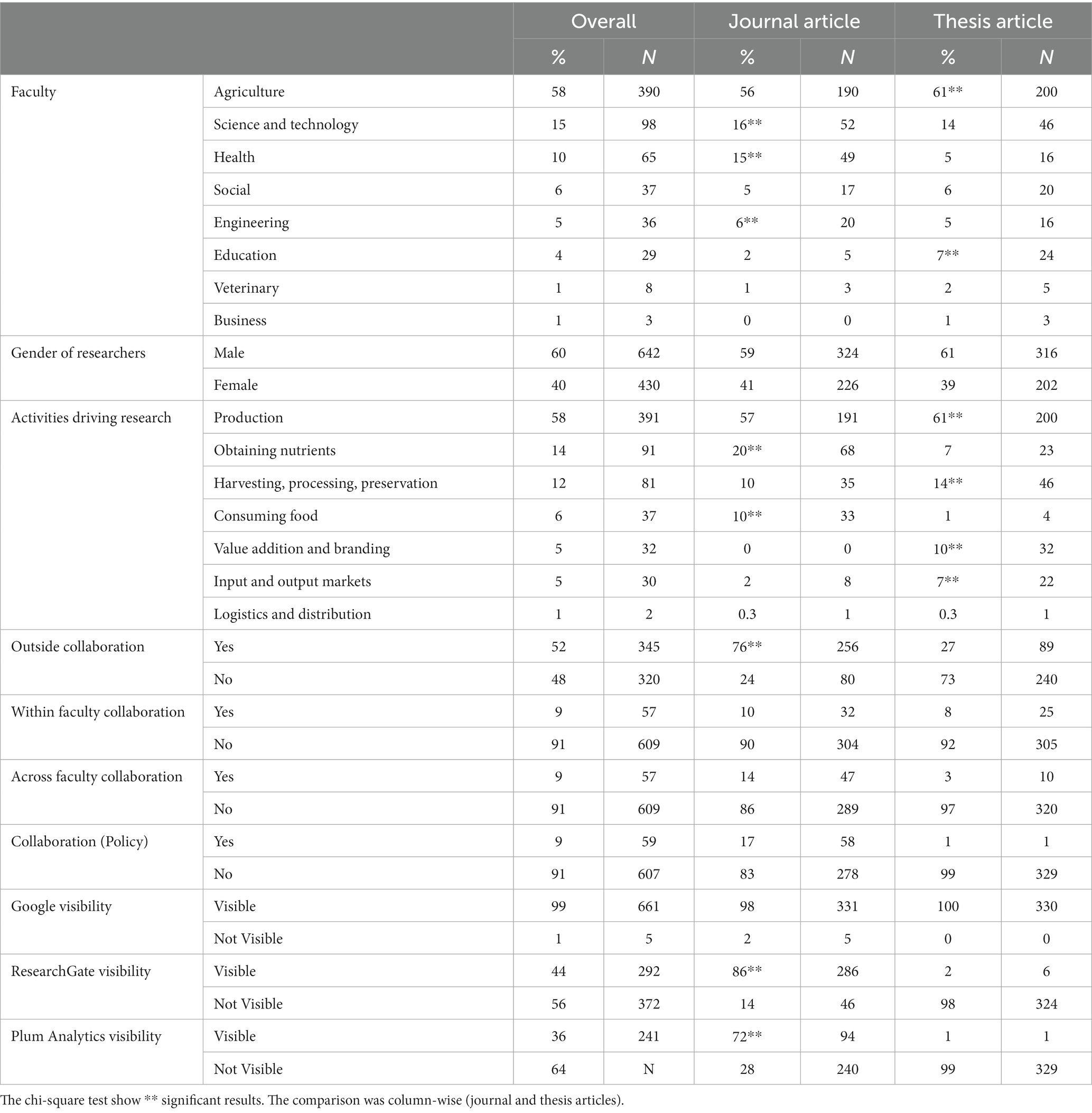
Table 2. The percentage and number of faculty, researchers by gender, food system activities, collaborations and visibility of research articles on food systems at the University of Nairobi.
A higher percentage of male researchers were involved in research for both the journal and thesis articles. This can be attributed to a higher number of male researchers compared to female within the university.
A chi-square test showed a highly significant correlation (p < 0.001) between the activities driving research on crops and article type (journal and thesis). Most of the journal articles had research outputs on production, obtaining nutrients, harvesting, processing, and preservation activities along the food systems value chain (Table 2). The thesis articles focused on value addition and branding. The least researched activities were input and output markets as well as logistics and distribution (Table 2).
A higher percentage of articles had collaborated with outside institutions on researched focused on crops. The chi-square test showed a high significance (p < 0.001) between outside collaborations and article type and a low significance (p = 015) across faculty and article type. There was no significant difference (p = 127) between faculty collaboration and article type. Within and across faculties, collaborations were few for both journal and thesis articles. Compared to journal articles, thesis articles had the least percentage of articles that had carried out collaborative research both outside and within faculty institutions. Very few articles had carried out studies with policy institutions (Table 2). Most articles were highly visible on Google Scholar followed by ResearchGate (Table 2). Few articles, especially theses, were visible on Plum Analytics.
Visibility of the journal articles at the faculty and department level
As shown in Table 3, journal articles under the faculties of agriculture, health, science and technology, and social sciences were highly visible in ResearchGate. However, the visibility of these articles was reduced in Plum Analytics.

Table 3. Visibility in ResearchGate and Plum Analytics search engines for journal articles from different faculties at the University of Nairobi.
The visibility of journal articles that were found under extra-mural, food science, land resources, chemistry, bioinformatics, and environmental and biosystems sciences was high in ResearchGate (Table 4). This visibility was reduced in Plum Analytics except for the extra-mural departments.
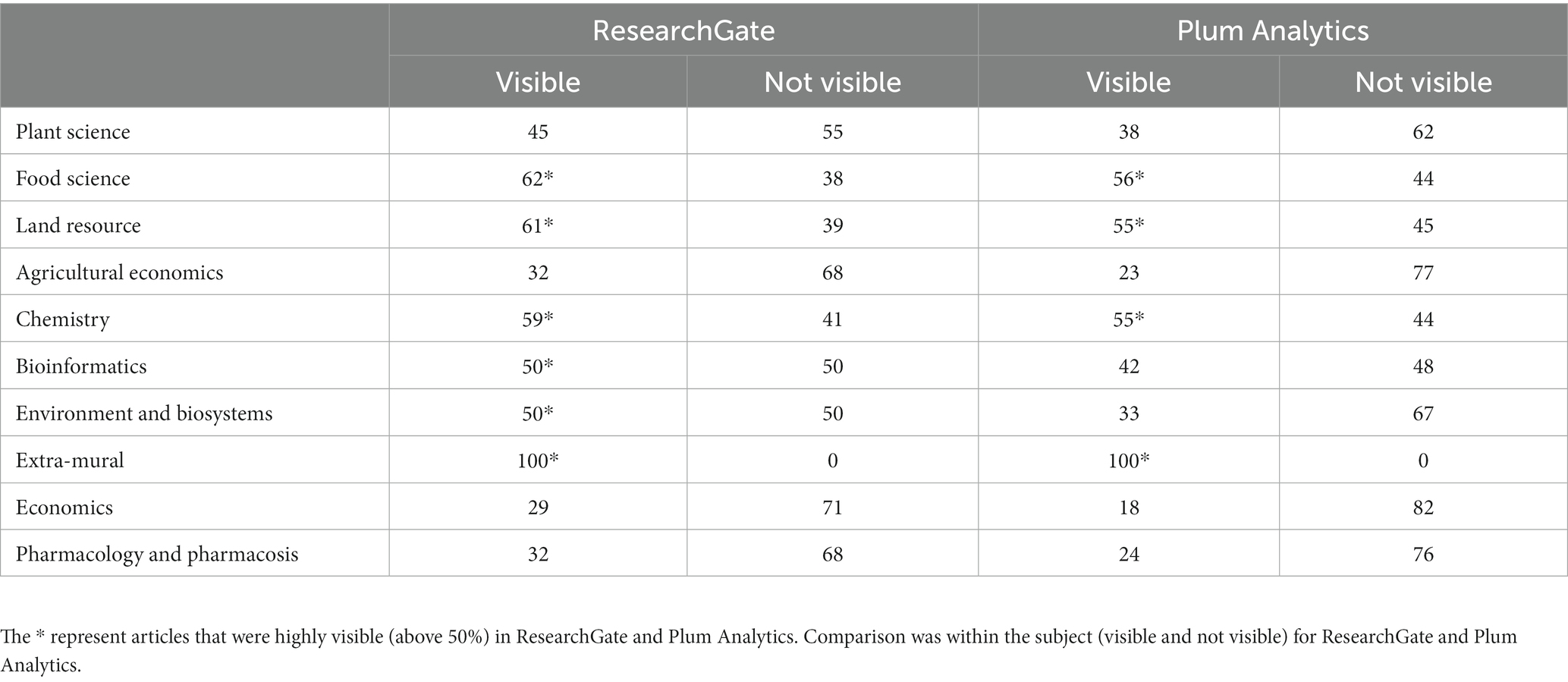
Table 4. Visibility in ResearchGate and Plum Analytics search engines for journal articles from different departments at the University of Nairobi.
Crops driving research at the University of Nairobi
The most researched crop was maize (Zea mays L.) followed by medicinal plants, African leafy vegetables, beans (Phaseolus vulgaris L.), cassava (Manihot esculenta), and sorghum (Sorghum bicolor) as shown in Figure 3. On the other hand, guava (Psidium guajava L.), passion fruit (Passiflora edulis), peanut (Arachis hypogaea), finger millet (Eleusine coracana L.), apple (Malus domestica), capsicum (Capsicum annuum), chickpea (Cicer arietinum), cotton (Gossypium herbaceum), green gram (Vigna radiata), lablab (Lablab purpureus), paw paw (Asimina triloba), and tobacco (Nicotiana tabacum) were the least researched crops.
Most crops had been researched under the faculty of Agriculture except medicinal plants (Figure 4). A high percentage of articles on medicinal plants were found under the faculty of Health. Sugarcane was also highly researched at the faculty of Business.
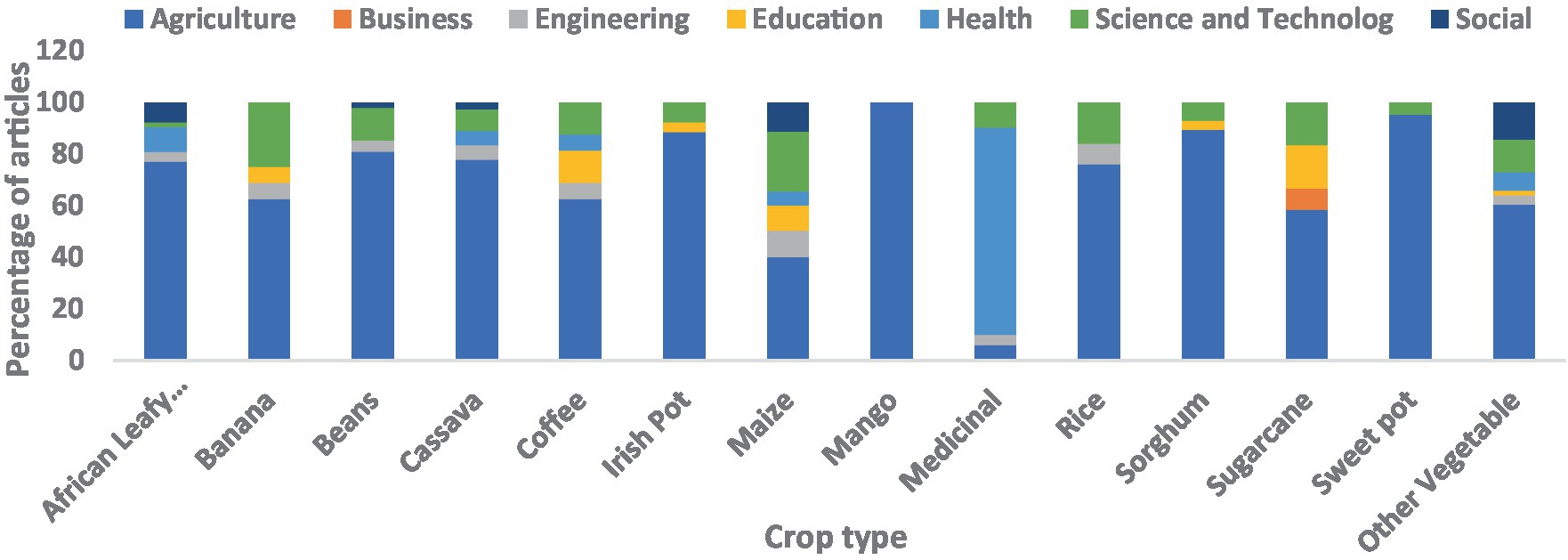
Figure 4. The percentage of commonly researched crops under different faculties at the University of Nairobi.
Figure 5 shows research on crops along the food systems value chain activities. Maize was the only crop that was researched along all seven food systems activities. African leafy vegetables and other vegetables (kales, tomatoes, cabbage, and lettuce) were researched on six of the seven food systems activities. Guava, pearl millet, apple, capsicum, chickpea, cotton, green grams, lablab, paw paw and tobacco were researched on one activity.
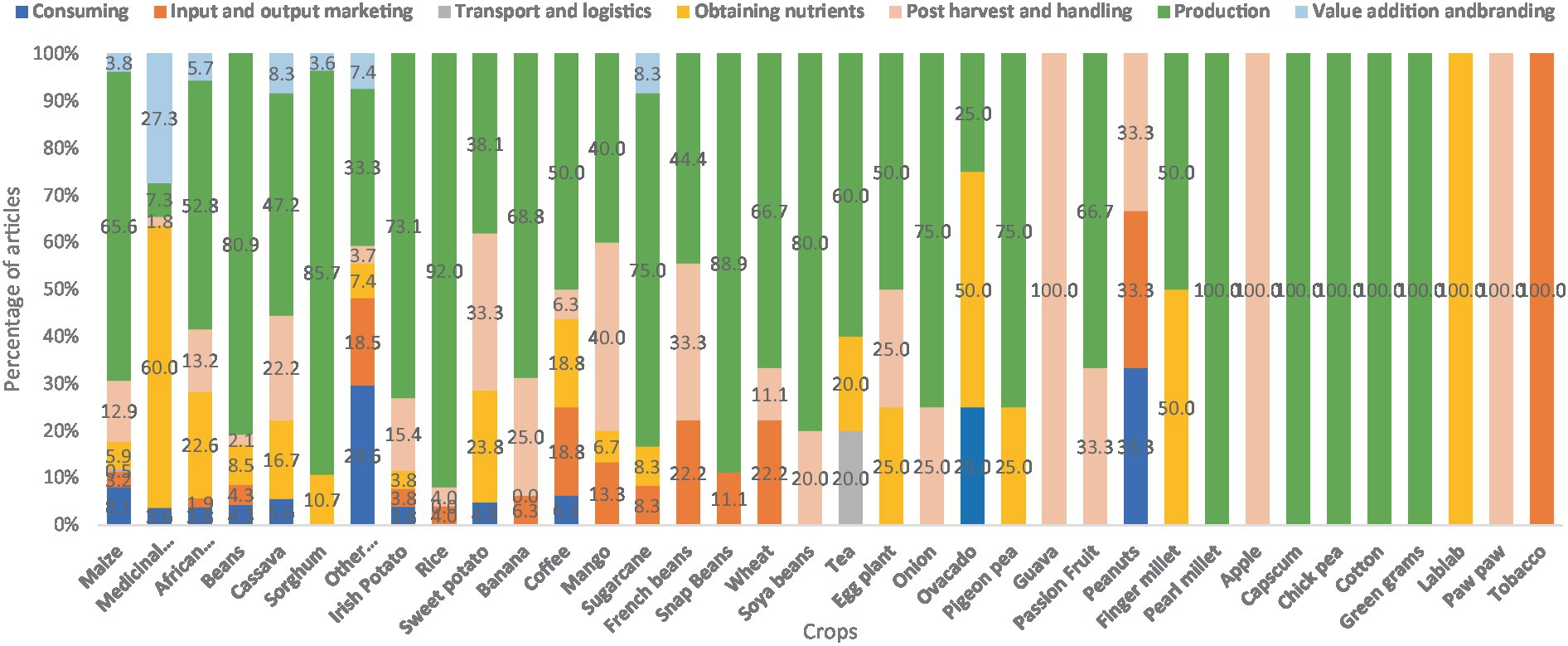
Figure 5. Percentage of articles with research on crops along the food systems value chain activities at the University of Nairobi.
Involvement of policy institution on researched crops at the University of Nairobi
Only 9% (59 of 666) of the articles collaborated with policy institutions. There was no statistically significance difference between faculty and policy institutions, activity and policy institutions as well as food system versus policy institution. The faculty of agriculture had the highest percentage of research articles that had collaborated with policy institutions, followed by the faculties of science and technology, health and engineering (Figure 6). The faculties of business, education, and social science did not have any research articles where policy institutions were involved.
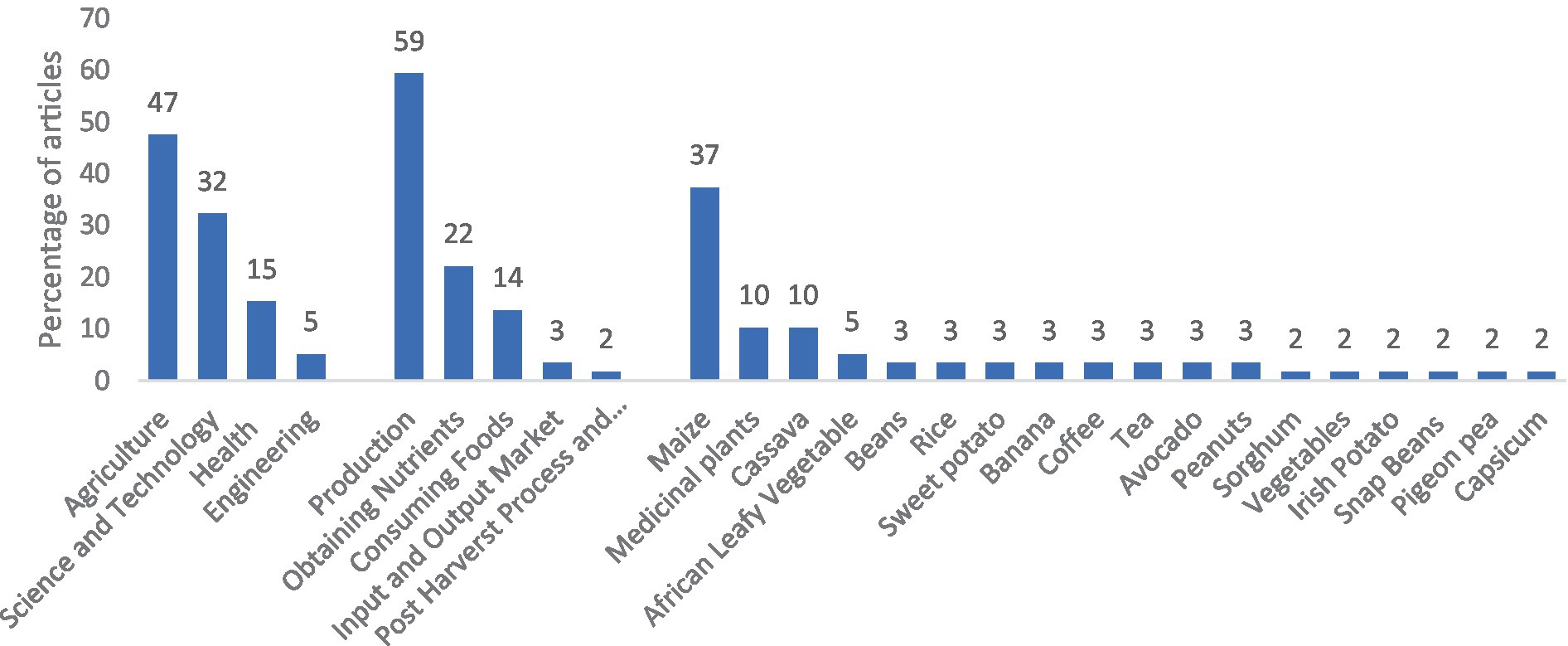
Figure 6. Percentage of articles which collaborated with policy institutions by faculty, food systems activity, and crop type at the University of Nairobi. Chi-square test between faculty, food system activity and food system each versus policy institution showed p values of 0.409, 0.696 and 0.613, respectively.
The production activity which entailed field management practices such as land preparation, planting, fertilizer application, weeding, pest and disease management, irrigation among others had the highest percentage of research articles involving policy institutions. The post-harvest activity had the least percentage of articles while the logistics and distribution as well as value addition and branding did not have any studies where policy institutions were involved.
A higher percentage of articles on maize had collaborated with policy institutions. Crops such as African Leafy Vegetables, bananas, beans, coffee, rice, sweet potato, Irish potato, sorghum, and other vegetables had few articles that had collaborated with policy institutions (Figure 6). Descriptive statistics is shown in Appendix Table 1.
Impact of research on food systems
The mean, minimum and maximum values for Google Scholar, ResearchGate, and Plum Analytics are shown in Table 5. There was a significant difference (p < 0.0001) in google citations between journal and thesis articles. The mean citation under Google Scholar was higher for journal articles compared to ResearchGate and Plum Analytics. The mean citation for thesis articles was lower compared to journal articles. The few thesis articles that were identified under ResearchGate had a high mean citation compared to journal articles. The mean and maximum value for article readership under ResearchGate was higher compared to Plum Analytics (p < 0.0001; Table 5).
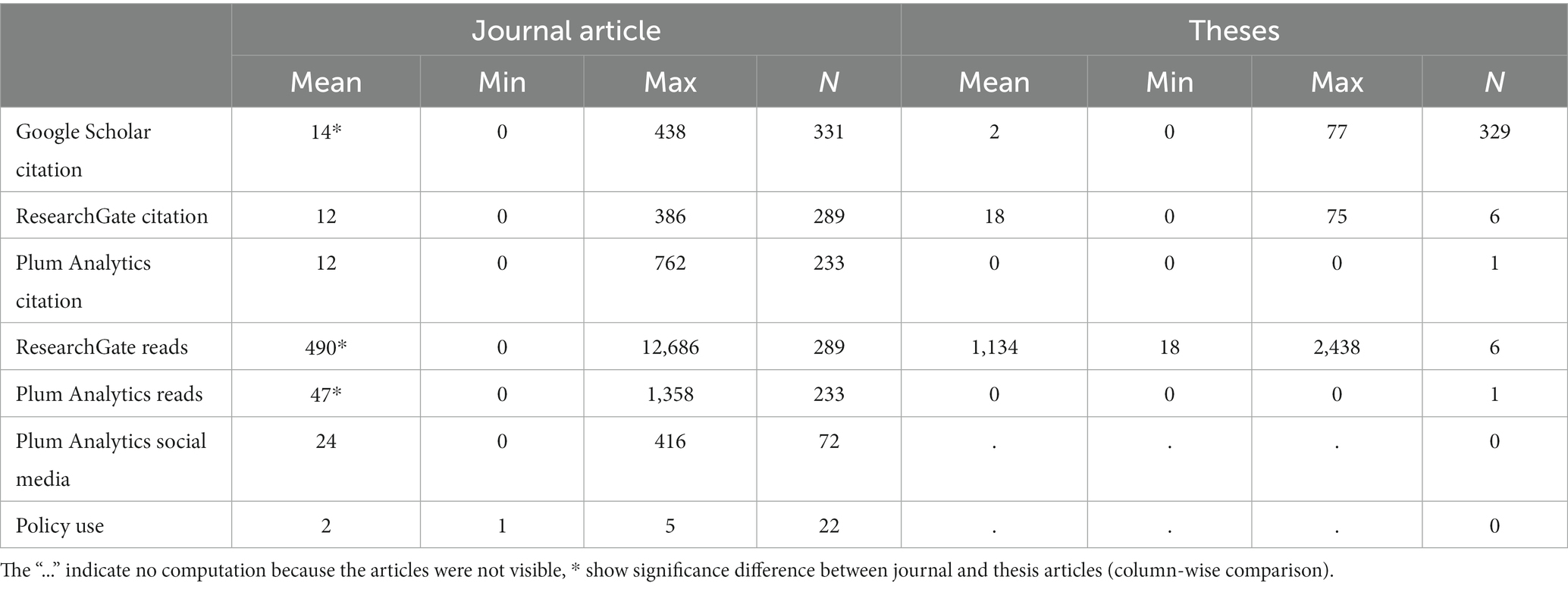
Table 5. Minimum, maximum, and mean value of citation scores, reads, social media scores and policy use from Google Scholar, ResearchGate and Plum Analytics for journal articles and theses published by the University of Nairobi.
Table 6 shows the influence of different faculty on Google Scholar citation scores for journal and thesis articles. Journal articles under the faculties of health, agriculture, science and technology, education, and social science highly influenced Google Scholar citation scores as shown by the significant p values and the positive coefficient values. Thesis articles under the faculty of education had a strong effect on google citation scores as shown by the highly significant value of p and high positive coefficient. Thesis articles under the faculties of agriculture and social science had a low influence on Google Scholar citations. Generally, the influence of different faculties on Google Scholar for journal articles was higher compared to thesis articles as shown by the high p and positive coefficient values.
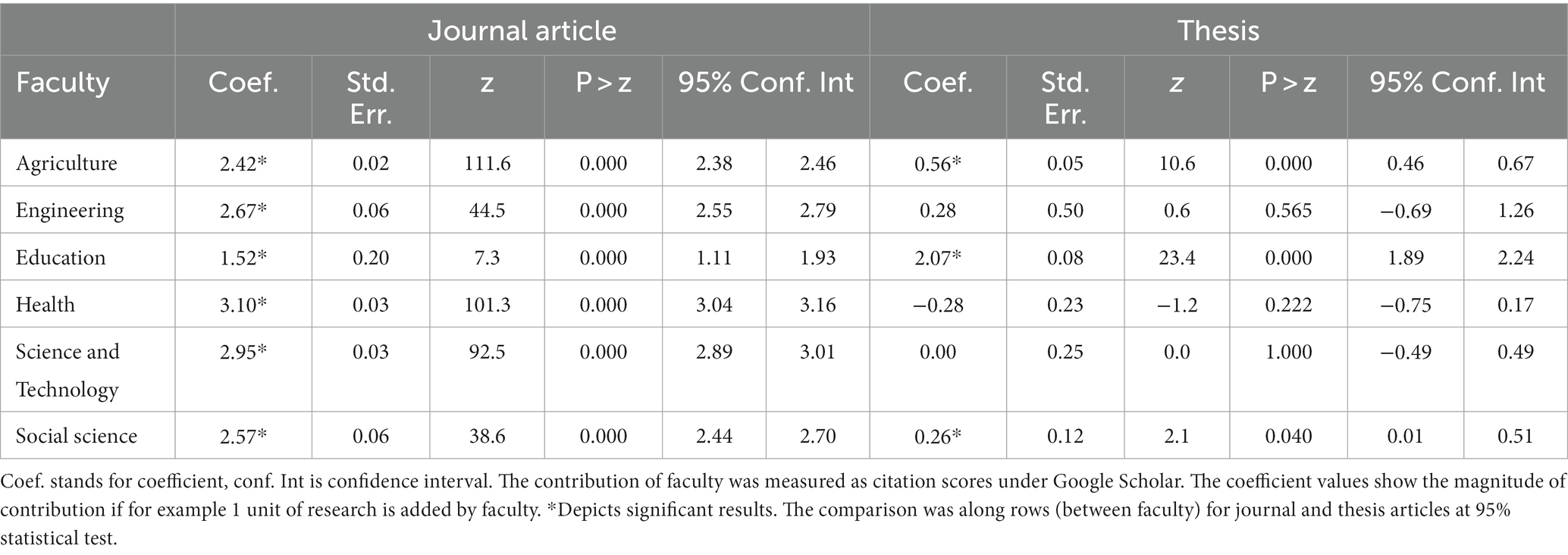
Table 6. Effect of faculty on google citation scores for journal and thesis articles at the University of Nairobi.
Table 7 shows the effect of the different departments on google citations for journal and thesis articles. Journal articles under the departments of environment and biosystems, food science, pharmacology and pharmacosis, economics, land resource, chemistry, bioinformatics, plant science, and agricultural economics significantly affected Google Scholar citations (p = 0.0001) in the listed order. While the order of influence on Google Scholar for thesis articles was as follows; environment and biosystems, agricultural economics, economics, land resource, and plant science influenced Google Scholar citations. Both journal and thesis articles under the department of environment and biosystems engineering had a high influence on Google Scholar citations as shown by the significant p values and high coefficient value in Table 7. Fewer departments for thesis articles influenced Google citations compared to journal articles as shown by significant p values.

Table 7. Effect of department on citation scores from Google Scholar for journal and thesis articles at the University of Nairobi.
Table 8 shows the effect of food systems activities on Google Scholar citations for journal and thesis articles. The contribution of food systems activities on Google Scholar citation for journal articles was high compared to thesis articles as shown by the significant p values and coefficients. Consuming foods and input and output activities under journal and thesis articles had a high influence on citation scores as shown by the significant p values and positive high coefficient values. Other activities that showed an influence on citation scores for journal articles included; obtaining nutrients, production, input and output markets, and post-harvest, processing and preservation. For thesis articles, production activity also influenced Google Scholar citations.
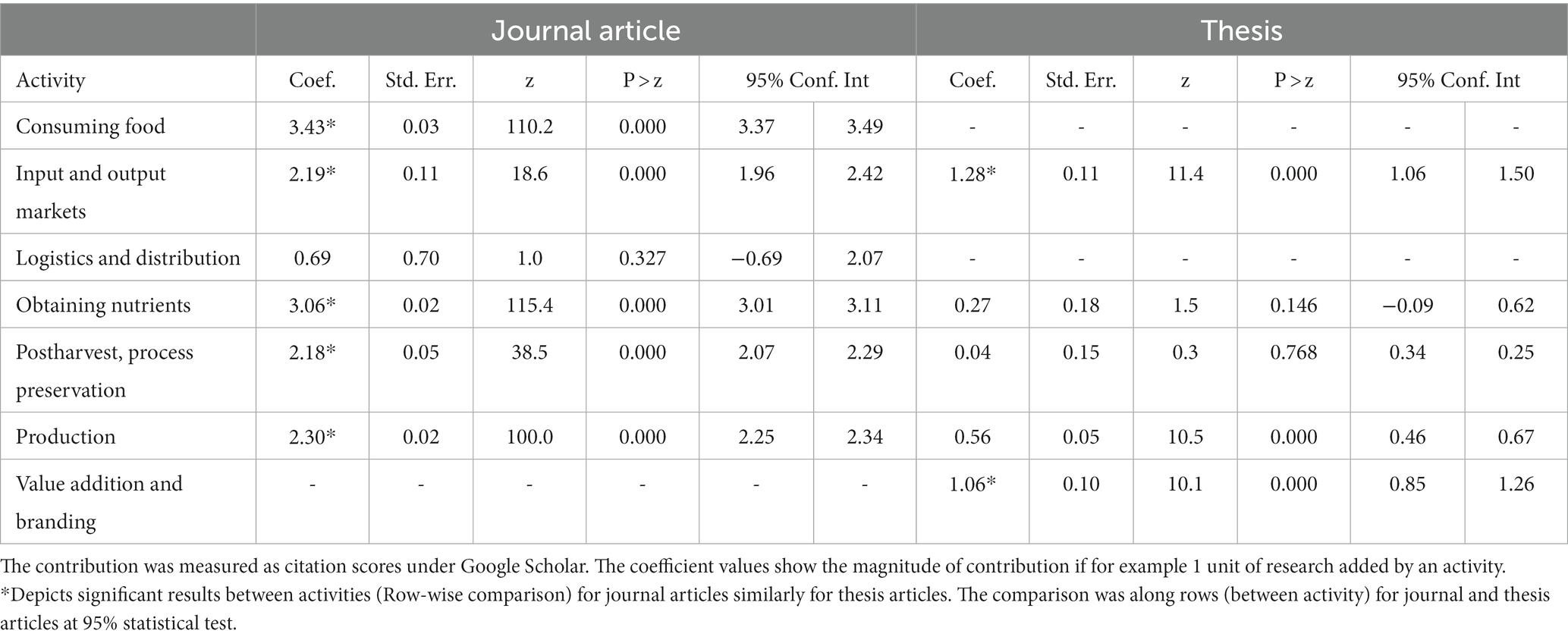
Table 8. The effect of food systems activities on Google Scholar citations for journal and thesis articles at the University of Nairobi.
Table 9 shows the effect of crops on Google Scholar citation scores. Journal articles with medicinal plants, maize, Irish potatoes, vegetables, sugarcane, sweet potato, cassava, and African Leafy Vegetables were highly cited under Google Scholar as shown by significant p-values and high coefficients (Table 9). While thesis articles that had mango, maize, and banana as the study crop were more cited under Google Scholar. There was a high citation for crops under journal articles as shown by the high coefficient values than thesis articles.
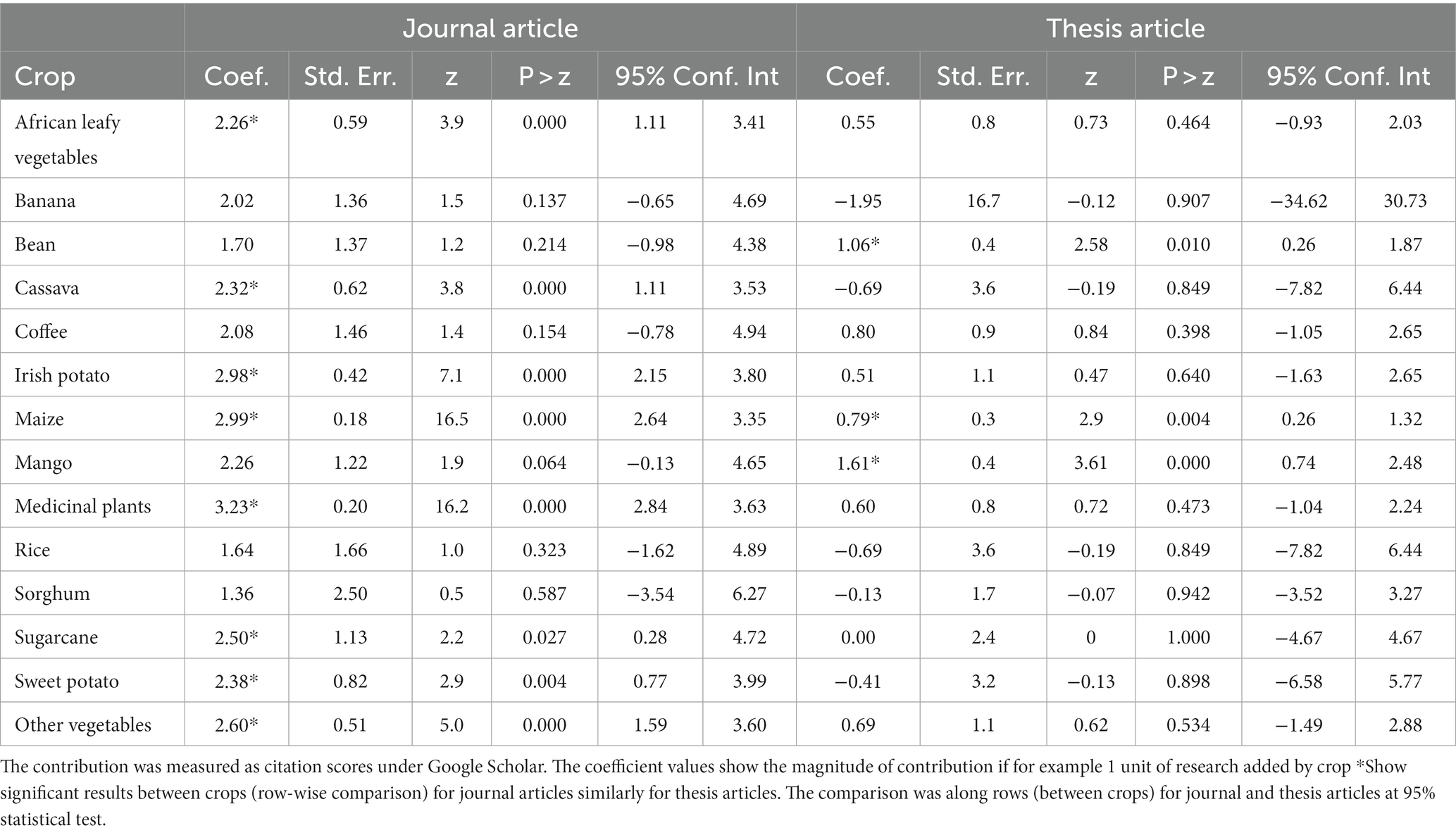
Table 9. The effect of different crops on Google Scholar citation scores for journal and thesis articles at the University of Nairobi.
The effect of collaborations with outside institutions on citations scores for journal articles was higher compared to thesis articles as shown by the high coefficient values and significant results (p = 0.0001) as shown in Table 10. Within faculty and across faculty collaborations for thesis articles had a higher influence on Google Scholar citation scores compared to journal articles as shown by the coefficient values.

Table 10. The influence of collaboration on Google citations for journal articles and theses at the University of Nairobi.
Most articles with collaboration were found within the East Africa as shown in Figure 7. There was also more collaboration in Europe and North America compared to other geographic regions within Africa.
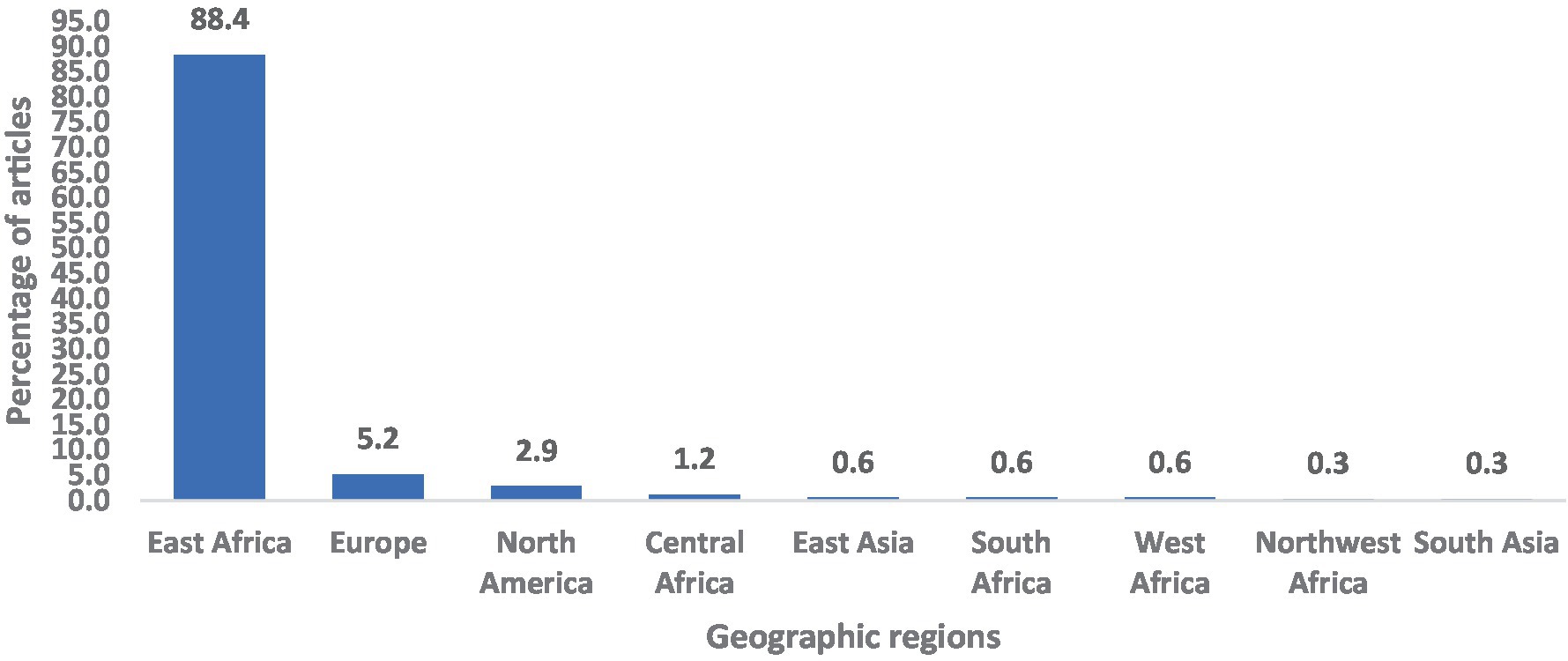
Figure 7. Percentage of articles with collaborations within and outside Africa at the University of Nairobi.
The collaborations led to wider coverage of topics of interest as shown in Figure 8. There was more focus on topics such as Nanotechnology, Food loss and food waste, Value chain analysis, Agro-ecological zoning and adoption when collaborations were within Africa. With collaborations outside Africa, the topics of focus included; Dietary related diseases, Nutrient uptake, Food biofortification, Food safety, Soil health, Herbal medicine, Crop modeling and Peri-urban and urban food systems.
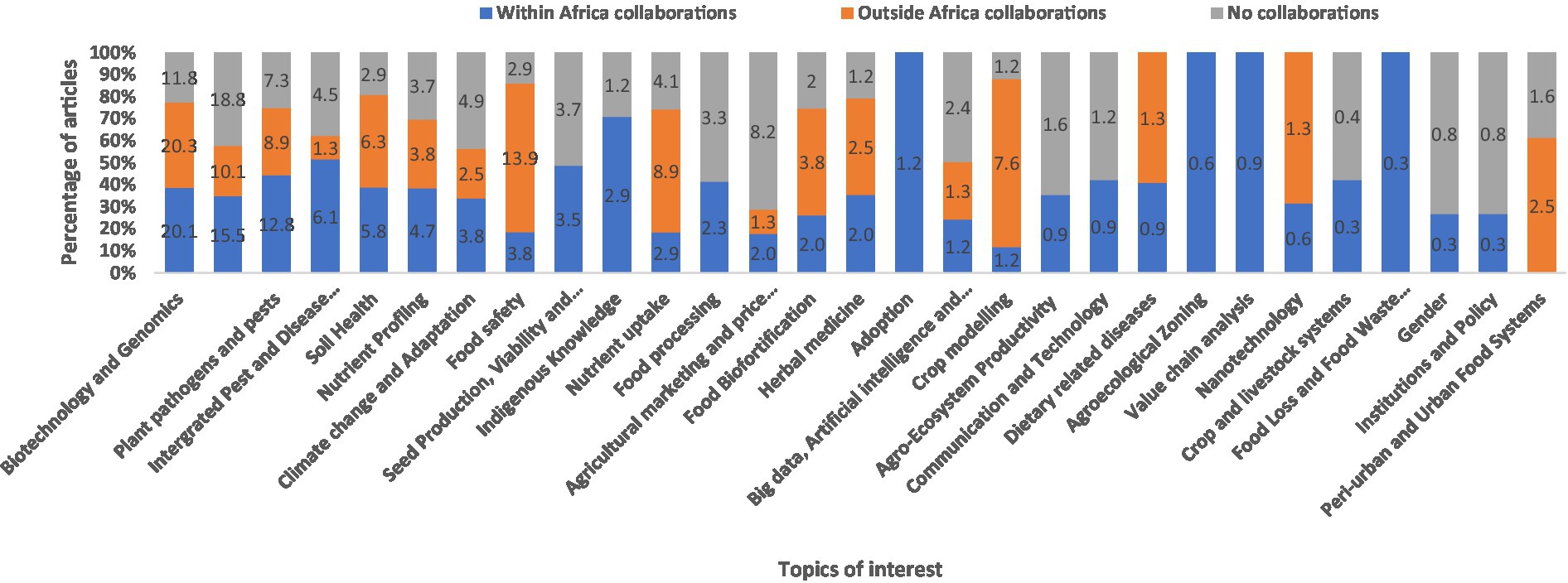
Figure 8. Percentage of articles showing topics of interest with collaborations (within and outside Africa) and with no collaboration at the University of Nairobi.
Discussion
Institutions driving research in food systems
Mapping studies across the globe have shown the application of research on food systems from higher institutions to achieving national objectives and the United Nation Sustainable Development Goals (SDGs). Cleveland and Jay (2020) demonstrated the importance of integrating climate and food policies at University of California-United States. Migliorini et al. (2020) showed the significance of student’s knowledge on food systems in influencing consumption patterns across higher education institutions in Europe. Nelles et al. (2022) discussed the contribution of higher education and agri-food systems to the SDGs from Chulalongkorn University, Thailand. Fox (2017) explored linkages in research and innovation, teaching and learning, outreach and engagement as well as resource stewardship to enhance food systems contribution in Ohio University-USA. A food systems dialogs by vice chancellors of higher education institutions across four geographic regions in Africa (southern, northern, eastern and western) identified information and technology, big data, policy, and practice as enablers of food systems transformation (Pretorius and Schönfeldt, 2023). The present investigation conducted a micro-institutional study (faculties and departments at the UoN) to understand the status of research studies and contribution to food systems. The study contributes to the current research discourse by identifying gaps and opportunities on research in food systems conducted by the university. The findings can help institutions of higher learning to improve food systems research and contribution to national development and the SDGs.
The current study showed low research outputs in food systems generated by the UoN compared to selected universities within Africa; Cape Town, Bostwana, Edward Mondlane, Mauritius, Ghana and Makerere (Cloete et al., 2018) and around the globe; Michigan, Cornell, Jiangsu, Oxford, Washington (Hongbo et al., 2021). This can be attributed to financial, infrastructural and human resource challenges which disincentivize researchers from conducting research (Cloete et al., 2018). The low research outputs have implications on the contribution of the institution to sustainable food security and development at the national and continental level. Sebola (2023) has also shown low research outputs and low contribution of research from universities to the South African national development goals from different disciplines such as economic management and sciences, life sciences, physical sciences, engineering and built environment, agriculture, mathematics and ICT, and military sciences.
There was low intra-institution collaboration within the UoN which can be attributed to reduced research funding (Tables 2, 10). Pouris and Ho (2014) also found low collaborative research within institutions attributed to low funding. Collaborations between local institutions has been shown to positively contribute to learning, thus contributing solutions to local problems (Van der Wouden and Youn, 2023). Low collaborations within the same institution (within and across faculty collaborations) was an indication of the low contribution of research on food systems to sustainable food security and nutrition locally. Challenges facing food systems are complex and require multifaceted solutions that are reflective of viewpoints from different disciplines. The low collaboration within the same faculty showed that research on food systems was conducted homogenously that is by single discipline. This implies that studies are focused on addressing a single problem and recommendations provided toward solving challenges of food systems are one dimensional. The contribution of research on food systems under the faculties of science and technology, health, social science and engineering, which was equal to the faculty of agriculture (Table 6), is an indication of the multiplier effect institutions can have on food systems if intra-institutional collaboration in research is enhanced. Therefore, fast tracking toward transdisciplinary research within local institutions is crucial for enhancing solutions to the challenges of food security and nutrition.
There was wider coverage on topics of interest with collaborations within and outside Africa (Figure 8). There was increased focus on topics such as Nanotechnology, Food loss and food waste, Value chain analysis, Agro-ecology zoning, Dietary related diseases, Nutrient uptake, Food biofortification, Food safety, Soil health, Herbal medicine, Crop modeling and Peri-urban and urban food systems. Haysom et al. (2019) has shown the benefits of collaboration between Europe and African institution in peri-urban and urban food systems in solving wicked problems. Food safety on increased uptake of dietary acrylamide among potato consumers has been investigated between African and European institutions (Abong et al., 2020). Dietary related diseases were also investigated in a collaborative study between American and African institutions (Neumann et al., 2013). Collaborations in research on food systems within and beyond Africa demonstrated a wider scope in research topics to solve challenges at the regional, continental and global level. The high collaborations between local and international institutions can be attributed to funding opportunities from international donors (Cloete et al., 2018). The limited funds within local universities has resulted in researchers relying on donor funding. As shown from the current study, there was a wider scope of focus on topical issues. However, donor dependent funding might have implications on the research focus as there is a tendency for studies to focus more on objectives that are inclined toward donor funding or collaborating institution purposes. The researchers may have limited control over the priority areas and often lack agency to introduce areas of focus that are reflective of local needs. Hence, there should be due consideration to include the local institutions objectives.
The contribution of research on food systems on policy formulation and implementation was low (Table 5). This could be attributed to low collaboration in research on food systems with policy institutions. Kushitor et al. (2022) has also shown a disjoint in the contribution of research and policy on food systems. The findings also show that a few disciplines; agriculture, science and technology, and health engaged in research studies with policy institutions. This has implications for policy formulation which is likely to be inclined toward the core areas of research along these disciplines which include production and health (Lind and Reeves, 2021). The low involvement of policy institutions in research studies conducted by the faculties of engineering, business, education and social sciences demonstrated low policy formulations that would improve research along core areas under these disciplines. These areas include; innovations, marketing, social and behavioral aspects. The involvement of policy institutions in research along the production, obtaining nutrients and consuming foods activities implied that policy formulation was likely to be done along these activities. Activities such as harvesting, processing and preservation, input and output markets, value addition and branding, logistics, and distribution lagged behind in policy formulation. Additionally, the involvement of policy institutions in research studies focused on maize indicated that policies to improve the production of maize were likely to be formulated (Grote et al., 2021). Other crops, such as beans, rice, sweet potatoes, and sorghum would likely receive less policy attention.
Food systems activities driving research on crops
Food systems where there is efficiency and coordination along the value chain activities from production to consumption has been deemed as one way of achieving sustainable food and nutrition security (Alexander et al., 2017). The findings of this study indicate gaps along the food systems value chain activities as most research studies were focused on production activity. Few articles focused on obtaining nutrients, post-harvest and processing, despite the high contribution of these activities as shown in Table 8. Little attention was focused on logistics and distribution, value addition and branding activities which reduced the impact of research on these activities (Table 8). The findings of the study also show integrated research on maize focusing on all the food systems activities (Figure 6), while crops such as guava, pearl millet, apple, capsicum, chickpea, cotton, green grams, lablab, paw paw, and tobacco received less attention along the food systems activities. The findings therefore demonstrated an imbalance along the food systems value chain for crops. This has reduced the contribution of these crops to sustainable food security. Ng’endo and Connor (2022) has also shown imbalances in food systems due to policies, food waste, food injustice, and undernutrition and recommended geographic specific strategies to achieve sustainable food systems. All food systems activities are important and ensure there is efficiency and coordination along the chain to connect production and consumption. The logistics and distribution activity enables connectivity with different territories and geographic regions creating a balance in the production and delivery of food products. Inefficiency along the logistics and distribution activity has been shown to increase food loss and create food insecurity (Horton et al., 2019). Additionally, increased production without proper post-harvest handling and value addition as well as branding results in reduced returns and income levels among producers (Docherty, 2012). Inclusively studying the food systems activities is therefore needed to enhance the benefits of crops grown in Africa namely; nutrient provision, income generation, industrial use, therapeutics, food loss and waste, among others (Horton et al., 2019).
Crops driving research
Crop diversity has been associated with dietary quality and quantity (Nicholson et al., 2021). The high frequency of research outputs on carbohydrate foods (maize, sorghum, cassava, Irish potato, sweet potato, and rice) than vitamin (vegetables and mango) and protein (beans) foods (Figure 3) demonstrate low crop diversity. This is contributing to low dietary quality and quantity; a situation that is increasing the food insecurity challenge. Manners and Van Etten (2018) also found high investment in high carbohydrate output foods compared to traditional crops like sweet potato. The high focus on maize and less attention paid to other crops indicates a rise in excessive intensification (monoculture) farming systems and erosion of biodiversity (Munialo et al., 2019; Bokelmann et al., 2022). Studies have pointed to the need to shift diets from animal to plant protein diets (beans) in order to reduce Greenhouse Gas emissions resulting from livestock as a mitigation toward climate change effects (Tilman et al., 2011; Benton and Thompson, 2016). Less research studies on leguminous crops as found in the present study shows the low contribution of research to reducing the impacts of climate change besides soil and water conservation measures. The high coefficient values (Table 9) for articles on medicinal plants, maize, Irish potato, vegetables, sugarcane, sweet potato, and sugarcane showed the high contribution of these crops to food security.
The role of traditional crops is multifaceted and include; dietary diversity, income generation, soil and water conservation, building resilience to climate change, among other uses (Sousa and Raizada, 2020). African Leafy Vegetables such as cowpea (Vigna unguiculata), amaranth (Amaranthus spp.), black nightshade (Solanum spp.), and spider plant (Cleome gynandra) among others, contain macro- and micronutrients that may not be available in other foods crops such as maize (Munialo et al., 2015; Owade et al., 2019; Sousa and Raizada, 2020). These nutrients are important for maintaining human health and building resistance against diseases. African Leafy Vegetables have also been shown to generate income on many smallholder farms (Pichop et al., 2016; Francesco and Knaepen, 2019). Apart from the dietary diversity and income generation, sorghum, cassava, ALVs, finger millet, and chickpea have been shown to have high capacity for climate change adaptability (Kinama and Ndiema, 2019; Beinah and Kunyanga, 2020). Despite the fact that Africa is home to approximately 400 traditional crops, as shown from the current study only a few crops are being studied at the UoN (Figures 3, 4). Focusing research on only a few crops implies that traditional crops are not being exploited to attain their full potential along the food systems value chain.
Opportunities for future research
The findings of these studies have identified gaps in research on food systems conducted at the UoN. Gaps exist within the institution, along the food systems activities and specific crops. These findings are important to guide research direction within institutions of higher learning and other research institutions. Opportunities exist in collaborative and transdisciplinary research, increasing visibility of research conducted, targeting specific under-utilized crop and food systems activities that have lagged behind.
Collaborative and transdisciplinary research
Traditionally, studies on food systems have predominantly involved institutions from the natural sciences. The findings of this study indicate that other disciplines such as health, engineering, and humanities are slowly being involved in research on food systems, a potential indication of transdisciplinary research. Building sustainable food systems requires a multidimensional approach that visualizes a food system as whole rather than separate entities (Bortoletti and Lomax, 2019). The involvement of many actors, across disciplines and industries is crucial. Leveraging on areas that have worked with collaborative research between local and global institutions could make a significant advancement in enhancing local collaborations. Priority areas that will advance transdisciplinary and collaborative research will include; building a database of researchers from different disciplines with interest in studying food systems. This will facilitate the connection of researchers across disciplines, institutions, countries and regions to conduct cutting edge research on food systems. Transdisciplinary research should also be supported by the development of frameworks that take into account the roles, trust, power relations, agency, communication, diversity in language, and working styles among the different actors. Michel (2019), has shown the success in implementation of collaborative research studies among heterogenous actors using a micro-institutional framework that builds on common perspectives. Building a common ground of understanding on a shared purpose and objectives among the different actors and disciplines is needed to improve the contribution of research to sustainable food systems. Capacity enhancement to enhance novel conceptual and methodological approaches that synthesize and extend discipline-specific perspectives, theories, methods, and translational strategies to yield innovative solutions among researchers is fundamental. Competency building among researchers on transdisciplinary approaches is needed. Research institutions are constrained by funding, human resources, a lack of state-of-the-art equipment, research facilities and pilot plants. The involvement of governments and funding institutions in supporting funding is also critical in advancing transdisciplinary research. The development of indices to measure transdisciplinary research outputs and its impact of food systems is also needed.
Increasing visibility of research articles
Increasing visibility and perceptibility is important to enhancing the impact of research articles (Ebrahim et al., 2014). The findings of this study have shown that the visibility of research findings in several search engines such as Google Scholar, ResearchGate and Plum Analytics contributed to increased citation. The visibility of journal articles in Google Scholar, ResearchGate and Plum Analytics was high compared to thesis articles which were mostly visible in Google Scholar. This resulted in a higher impact for journal articles compared to thesis articles. As efforts are made to improve research on food systems, consideration to increase the visibility of the findings to multiple stakeholders is important. Emphasis should be placed on increasing visibility of thesis articles that are produced by students as they contain rich information that should be exploited. Other than search engines, social media platforms such as LinkedIn, Twitter and media stations such TV and radio among others are platforms that can be used to enhance the visibility of the findings. Additionally, creating dialogs with stakeholders including scientists, policy makers, industry players, development agencies, and farmers at different levels can increase the visibility and usability of research findings. This will require that the information is synthesized to simple comprehensible messages.
Research along the food systems activities
The findings of this study show that activities such as input and output markets, logistics and distribution and value addition and branding as well as consuming foods lagged behind in research. All the food systems activities should be considered to improve efficiency. Promoting transdisciplinary research between agricultural and business/economic institutions together with industry players will help reduce inefficiencies that exist along the input and output markets activity. Collaborative research between agricultural and engineering sciences is needed to improve efficiencies along the logistics and distribution as well as the value addition and branding activities. Opportunities also exist in research studies between the agricultural and social sciences.
Traditional crops
Despite the fact that the African continent contain more than 400 traditional crop species, the findings of this study showed that very few crops (15) were commonly researched, with maize being the most intensively researched crop. The findings show that traditional crops were not adequately studied along the food systems value chain. These has resulted in traditional crops not being fully exploited to attain their full potential leading to low impact of the crops to sustainable food systems. Traditional crops have been branded super foods that can transform the continents food status and contribute to sustainable food security (Bokelmann et al., 2022). New research perspectives that bring out the value of these crops are needed. Transdisciplinary research along the traditional crops value chain activity will contribute to unleashing the potential of the crops. Collaboration among different disciplines will approach research from a multi-dimensional angle that created solutions to complex challenges. Promoting transdisciplinary research with global institutions will also help exploit traditional crops beyond local usability.
Policy formulation
Policy formulation is integral to food systems and help advance reforms that improve the impact of research findings. Due to the complexity of food systems, policy formulation along each food system activity is crucial. Formulating policies that account for systematic interactions between the different institutions, food systems activities and specific crops is important to help unleash the potential of these crops hence the need to increase the involvement of policy institutions in research.
Conclusion and recommendations
The study conducted a micro-institutional analysis review exercise on research on food systems at the University of Nairobi, Kenya. The aim was to identify institutions, activities, and crops driving research on food systems at the university. Low research outputs on food systems when compared to other similar institutions across the globe were observed. There was more collaborative research between local and global institutions than within local institutions. Disparities in research existed along the food systems value chain with more focus on production activity and little on post-harvest processing and preservation together with obtaining nutrients activities. Most activities; consuming foods, value addition and branding, input and output markets as well as logistics and distribution activities received less attention. There was high focus on carbohydrate rich foods (maize, sorghum, cassava, Irish potato, sweet potato, and rice) compared to vitamin (vegetables, and mango) and protein rich (beans) foods. The involvement of policy institutions in research studies on food systems was low and inclined to specific disciplines, value chain activities and few crops. Gaps along the mentioned components contributed to reduce the impact of research on food systems toward sustainable food security and nutrition with the input of thesis articles produced by students being less than journal articles. The findings also showed that disciplines such as health, science and technology, engineering and humanities were involved in research in addition to agricultural disciplines, a potential indication of transdisciplinary research, at the UoN. The study suggests for future research to close the gaps in research within local institutions, along food systems activities, policy, crops to increase the relevance toward sustainable food security. Increasing research funding by government is needed to foster intra-institutional collaborations, and transdisciplinary research on under-researched crops. Creation of awareness among researchers on the importance of intra-institutional research and collaboration with policy institutions and industry is also needed as well as increasing the visibility of the findings through media platforms. Further studies can focus on developing frameworks to advance transdisciplinary research.
Data availability statement
The raw data supporting the conclusions of this article will be made available by the authors, without undue reservation.
Author contributions
SM and LS idea conception. SM developed the theory and performed the computations. CO, JL, OW, JM, JN methodology verification. CO and LS supervised the findings of this work. AD and SM proof reading and editing. All authors contributed to the article and approved the submitted version.
Conflict of interest
The authors declare that the research was conducted in the absence of any commercial or financial relationships that could be construed as a potential conflict of interest.
Publisher’s note
All claims expressed in this article are solely those of the authors and do not necessarily represent those of their affiliated organizations, or those of the publisher, the editors and the reviewers. Any product that may be evaluated in this article, or claim that may be made by its manufacturer, is not guaranteed or endorsed by the publisher.
Supplementary material
The Supplementary material for this article can be found online at: https://www.frontiersin.org/articles/10.3389/fsufs.2023.1125094/full#supplementary-material
References
Abong, G. O., Ogolla, J. A., Okoth, M. W., De Meulenaer, B., Kabira, J. N., Karanja, P., et al. (2020). Dietary acrylamide intake by potato crisps consumers: a case of Nairobi County. Open Agric. 5, 871–878. doi: 10.1515/opag-2020-0086
Akinola, R., Pereira, L. M., and Mabhaudhi, T. (2021). A review of indigenous food crops in Africa and the implications for more sustainable and healthy food systems. Sustainability 12, 1–29. doi: 10.3390/su12083493.A
Alarcon, P., Dominguez-Salas, P., Fèvre, E. M., and Rushton, J. (2021). The importance of a food systems approach to low and middle income countries and emerging economies: a review of theories and its relevance for disease control and malnutrition. Front. Sustain. Food Syst. 5:642635. doi: 10.3389/fsufs.2021.642635
Alexander, P., Brown, C., Arneth, A., Finnigan, J., Moran, D., and Rounsevell, M. D. A. (2017). Losses, inefficiencies and waste in the global food system. Agric. Syst. 153, 190–200. doi: 10.1016/j.agsy.2017.01.014
Ali, R. T., Kunyanga, C. N., and Ngugi, K. (2021). In-vitro protein digestibility, physico-chemical properties and nutritional quality of sorghum-green gram cookies supplemented with mango powder. Int. J. Food Nutr. Res. 5, 1–15.
Arenas-Monreal, L., Cortez-Lugo, I., Pacheco-Magaña, L. E., and Magaña-Valladares, L. (2015). Population health diagnosis with an ecohealth approach. J. Public Health 49, 1–8. doi: 10.1590/S0034-8910.2015049005842
Beinah, A., and Kunyanga, C. (2020). Utilization and processing of Sorghum by small holder farmers in drought prone agro-ecological zones of Kenya. Adv. Soc. Sci. Res. 7, 116–121. doi: 10.14738/assrj.710.8540
Benton, T., and Thompson, C. (2016). Food system framework, a focus on food sustainability. Food Sci. Technol. 30:4. doi: 10.1002/fsat.3003_4.x
Berger-gonzález, M., Stauffacher, M., Zinsstag, J., Edwards, P., and Krütli, P. (2016). Transdisciplinary research on cancer- healing systems between biomedicine and the Maya of Guatemala: a tool for reciprocal reflexivity in a multi- epistemological setting. Qual. Health Res. 26, 77–91. doi: 10.1177/1049732315617478
Black, L., Panayiotou, M., and Humphrey, N. (2019). The dimensionality and latent structure of mental health difficulties and wellbeing in early adolescence. PLoS One 14:e0213018. doi: 10.1371/journal.pone.0213018
Bokelmann, W., Huyskens-keil, S., Ferenczi, Z., Stöber, S., and Kennedy, G. (2022). The role of indigenous vegetables to improve food and nutrition security: experiences from the project HORTINLEA in Kenya (2014–2018). Front. Sustain. Food Syst. 6, 1–19. doi: 10.3389/fsufs.2022.806420
Borman, G. D., De Boef, W. S., Dirks, F., Gonzalez, Y. S., Subedi, A., Thijssen, M. H., et al. (2022). Putting food systems thinking into practice: integrating agricultural sectors into a multi-level analytical framework. Global. Food Secur. 32:100591. doi: 10.1016/j.gfs.2021.100591
Bortoletti, M., and Lomax, J. (2019). Collaborative framework for food systems transformation for sustainable food systems. Available at: https://www.oneplanetnetwork.org/sites/default/files/un-e_collaborative_framework_for_food_systems_transformation_final.pdf.
Cairns, J. E., Chamberlin, J., Rutsaert, P., Voss, R. C., and Ndhlela, T. (2021). Challenges for sustainable maize production of smallholder farmers in. J. Cereal Sci. 101, 103274–103278. doi: 10.1016/j.jcs.2021.103274
Chastin, S. F. M., De Craemer, M., Lien, N., Bernaards, C., Buck, C., Oppert, J., et al. (2016). The SOS-framework (Systems of Sedentary behaviours): an international transdisciplinary consensus framework for the study of determinants, research priorities and policy on sedentary behaviour across the life course: a DEDIPAC-study. Int. J. Behav. Nutr. Phys. Act. 13:83. doi: 10.1186/s12966-016-0409-3
Claasen, N., and Lemke, S. (2015). Applying a transdisciplinary mixed methods research design to explore sustainable diets in rural South Africa. Int J Qual Methods 14, 69–91. doi: 10.1177/160940691501400207
Clancy, K. (2017). Transdisciplinary and systems approaches to food security. J. Agric. Food Syst. Community Dev. 7, 13–16.
Cleveland, D. A., and Jay, J. A. (2020). Integrating climate and food policies in higher education: a case study of the University of California. Clim. Pol. 21, 16–32. doi: 10.1080/14693062.2020.1787939
Committee on World Food Security. (2017). Good practices and lesson sharing for improved nutrition: Investments for healthy food systems (issue august). Available at: https://www.google.com/search?client=firefox-b-d&q=GOOD+PRACTICES+AND+LESSON+SHARING+FOR+IMPROVED+NUTRITION%3A+INVESTMENTS+FOR+HEALTHY+FOOD+SYSTEMS.
Conaty, F. (2021). Abduction as a methodological approach to case study research in management accounting – an illustrative case. Account. Finance Gov. Rev. 27:22171. doi: 10.52399/001c.22171
Dekeyser, K., Rampa, F., D’Alessandro, C., and Bizzotto Molina, P. (2020). The food systems approach in practice: Our guide for sustainable transformation, No. 278. Available at: https://www.ecdpm.org/dp278.
Docherty, C. (2012). Branding agricultural commodities: the development case for adding value through branding. International Institute for Environment and Development. Available at: https://www.sustainablefoodlab.org/projects/%0Ahttps://ezp.lib.unimelb.edu.au/login?url=https://search.ebscohost.com/login.aspx?direct=true&db=edszbw&AN=EDSZBW719494540&site=eds-live&scope=site.
Duressa, E. (2018). The socio-cultural aspects of coffee production in southwestern Ethiopia: an overview. J. Cult. Soc. Dev. 38, 14–23.
Ebrahim, N. A., Salehi, H., Embi, M. A., Tanha, F. H., and Gholizadeh, H. (2014). Visibility and citation impact. Int. Educ. Stud. 7, 120–125. doi: 10.5539/ies.v7n4p120
Fam, D. (2016). A ‘knowledge ecologies’ analysis of co-designing water and sanitation services in Alaska. Sci. Eng. Ethics 23, 1059–1083. doi: 10.1007/s11948-016-9830-x
Fox, J. M. (2017). Collective approach to complex food system issues, the case of the Ohio State University. Metropolitan Univ. 28, 94–112. doi: 10.18060/21470
Francesco, R., and Knaepen, H. (2019). Sustainable food systems through diversification and indigenous vegetables (issue July). Available at: https://ecdpm.org/wp-content/uploads/SASS-report-I_Sustainable-food-systems-through-diversification-and-indigenous-vegetables.pdf.
FSNET. (2021). ARUA-UKRI GCRF food systems research network for Africa list of figures (issue July). FSNET.
Gitari, H. I., Nyawade, S. O., Kamau, S., Gachene, C. K. K., Karanja, N. N., and Schulte-Geldermann, E. (2019). Increasing potato equivalent yield increases returns to investment under potato-legume intercropping systems. Open Agric. 4, 623–629. doi: 10.1515/opag-2019-0062
Grote, U., Fasse, A., Nguyen, T. T., and Erenstein, O. (2021). Food security and the dynamics of wheat and maize value chains in Africa and Asia. Front. Sustain. Food Syst. 4, 1–17. doi: 10.3389/fsufs.2020.617009
Haysom, G., Olsson, E. G. A., Dymitrow, M., Opiyo, P., Buck, N. T., Oloko, M., et al. (2019). Food systems sustainability: an examination of different viewpoints on food system change. Sustainability 11, 1–17. doi: 10.3390/su11123337
Holka, M., and Bieńkowski, J. (2020). Carbon footprint and life-cycle costs of maize production in conventional and non-inversion tillage systems. Agronomy 10:1877. doi: 10.3390/agronomy10121877
Hongbo, L., Thige, J. M., and William, S. M. (2021). Demystifying the University of Nairobi’s academic quality through third party ranking assessment. Int. J. Res. Innov. Soc. Sci. 5, 765–772.
Horton, P., Bruce, R., Reynolds, C., and Milligan, G. (2019). Food chain inefficiency (FCI): accounting conversion efficiencies across entire food supply chains to re-define food loss and waste. Front. Sustain. Food Syst. 3, 1–11. doi: 10.3389/fsufs.2019.00079
Ichami, S. M., Shepherd, K. D., Hoffland, E., Karuku, G. N., and Stoorvogel, J. J. (2020). Soil spatial variation to guide the development of fertilizer use recommendations for smallholder farms in western Kenya. Geoderma Reg. 22:e00300. doi: 10.1016/j.geodrs.2020.e00300
Ilangovan, K., Muthappan, S., Govindarajan, K., and Vairamani, V. (2022). Transdisciplinarity of India’s master’s level public health programmes: evidence from admission criteria of the programmes offered since 1995. Hum. Resour. Health 4, 1–11. doi: 10.1186/s12960-022-00713-4
IPBES. (2019). The global assessment report on biodiversity and ecosystem services. In intergovernmental science-policy platform on biodiversity and ecosystem services (vol. 45, issue 3). Available at: https://zenodo.org/record/3553579#.YfmYTerMI2w
Jekayinoluwa, T., Tripathi, L., Tripathi, J. N., Ntui, V. O., Obiero, G., Muge, E., et al. (2020). RNAi technology for management of banana bunchy top disease. Food Energy Secur. 9, 1–15. doi: 10.1002/fes3.247
Kariuki, P. M., Onyango, C. M., Lukhoba, C. W., and Njoka, J. T. (2018). The role of indigenous knowledge on use and conservation of wild medicinal food plants in Loita sub-county, Narok County. Asian J. Agric. Ext. Econ. Soc. 28, 1–9. doi: 10.9734/AJAEES/2018/45032
Kathure, M., Kavoi, M. M., and Turoop, L. (2019). Analysis of market trends and consumption of indigenous vegetables in Meru and Tharaka Nithi counties (upper eastern Kenya). J. Emerg. Trends Econ. Manag. Sci. 10, 24–32.
Kimondo, J., Miaron, J., Mutai, P., and Njogu, P. (2015). Author’s accepted manuscript. J. Ethnopharmacol. 175, 463–469. doi: 10.1016/j.jep.2015.10.013
Kinama, J., and Ndiema, G. (2019). Sorghum production practices in an integrated crop-livestock production system in Makueni County, Eastern Kenya. Trop. Sub Trop. Agroecosyst. 22, 13–23. doi: 10.56369/tsaes.2508
Kushitor, S. B., Drimie, S., Davids, R., Delport, C., Hawkes, C., Mabhaudhi, T., et al. (2022). The complex challenge of governing food systems: the case of south African food policy. Food Secur. 14, 883–896. doi: 10.1007/s12571-022-01258-z
Lancho-Barrantes, B. S., and Cantu-Ortiz, F. J. (2021). Quantifying the publication preferences of leading research universities. Scientometrics 126, 2269–2310. doi: 10.1007/s11192-020-03790-1
Liberati, A., Altman, D. G., Tetzlaff, J., Mulrow, C., Gøtzsche, P. C., and John, P. A. (2009). The PRISMA statement for reporting systematic reviews and meta-analyses of studies that evaluate healthcare interventions: explanation and elaboration. BMJ Online 339:27. doi: 10.1136/bmj.b2700
Lind, C. J., and Reeves, M. L. (2021). Making food-systems policy for local interests and common good. Front. Commun. 6, 1–14. doi: 10.3389/fcomm.2021.690149
Lugo-Morin, D. R. (2020). Indigenous communities and their food systems: a contribution to the current debate. J. Ethnic Foods 7, 1–10. doi: 10.1186/s42779-019-0043-1
Makate, C. (2020). Local institutions and indigenous knowledge in adoption and scaling of climate-smart agricultural innovations among sub-Saharan smallholder farmers. Int. J. Clim. Change Strateg. Manage. 12, 270–287. doi: 10.1108/IJCCSM-07-2018-0055
Malavi, D. N., Abong, G. O., and Muzhingi, T. (2021). Effect of food safety training on behavior change of food handlers: a case of orange-fleshed sweetpotato purée processing in Kenya. Food Control 119:107500. doi: 10.1016/j.foodcont.2020.107500
Manners, R., and Van Etten, J. (2018). Are agricultural researchers working on the right crops to enable food and nutrition security under future climates? Glob. Environ. Chang. 53, 182–194. doi: 10.1016/j.gloenvcha.2018.09.010
Mibei, E. K., Ambuko, J., Giovannoni, J. J., Onyango, A. N., and Owino, W. O. (2016). Carotenoid profiling of the leaves of selected African eggplant accessions subjected to drought stress. Food Sci. Nutr. 5, 112–122. doi: 10.1002/fsn3.370
Michel, S. (2019). Collaborative institutional work to generate alternative food systems. FoodReview 27, 314–336. doi: 10.1177/1350508419883385
Migliorini, P., Wezel, A., Veromann, E., Strassner, C., Średnicka-Tober, D., Kahl, J., et al. (2020). Students’ knowledge and expectations about sustainable food systems in higher education. Int. J. Sustain. High. Educ. 21, 1087–1110. doi: 10.1108/IJSHE-12-2019-0356
Mondo, M. J., Kimani, P. M., and Narla, R. D. (2018). Marker-assisted gamete selection for multiple disease resistance and grain yield in inter-gene pool and inter-racial populations of common bean. Afr. J. Rural Dev. 3, 931–941.
Moyo, M. P., Tatsvarei, S., and Rukasha, T. (2022). Commercialization of indigenous vegetable value chains: a review of selected African countries. Int. J. Dev. Sustain. 11, 184–201.
Mukami, A., Ngetich, A., Syombua, E., Oduor, R., and Mbinda, W. (2020). Varietal differences in physiological and biochemical responses to salinity stress in six finger millet plants. Physiol. Mol. Biol. Plants 26, 1569–1582. doi: 10.1007/s12298-020-00853-8
Muller, M. (2012). Generalized linear models. In: J. E. Gentle, W. K. Härdle, and Y. Mori Hand book of computational statistics. Berlin, Heidelberg: Springer, pp. 1–1192.
Munialo, S., Akundabweni, L., Mburu, J., Namutebi, A., and Kyasi, J. (2015). Investigating viability of the premium influenced land agro-usage structure for production of African leafy vegetables in Vihiga and Jinja. Afr. J. Agric. Res. 10, 1659–1674. doi: 10.5897/AJAR2014.9389
Munialo, S., Dahlin, S. A., Onyango, C. M., Kosura, O. W., Marstorp, H., and Öborn, I. (2019). Soil and management-related factors contributing to maize yield gaps in western Kenya. Food and energy. Security 9, 1–17. doi: 10.1002/fes3.189
Mwizerwa, H., Abong, G. O., Mbugua, S. K., Okoth, M. W., Gacheru, P., Muiru, M., et al. (2018). Profiling of microbial content and growth in fermented maize based products from Western Kenya. Curr. Res. Nutr. Food Sci. 6, 509–519. doi: 10.12944/CRNFSJ.6.2.25
Nelles, W., Visetnoi, S., Middleton, C., and Orn-in, T. (2022). Sustainability: lessons from Chulalongkorn University. Environ. Dev. Sustain. 24, 10975–10996. doi: 10.1007/s10668-021-01892-1
Neumann, C. G., Oace, S. M., Chaparro, M. P., Herman, D., Drorbaugh, N., and Bwibo, N. O. (2013). Low vitamin B12 intake during pregnancy and lactation and low breastmilk vitamin B12 content in rural Kenyan women consuming predominantly maize diets. Food Nutr. Bull. 34, 151–159. doi: 10.1177/156482651303400204
Ng’endo, M., and Connor, M. (2022). One size does not fit all—addressing the complexity of food system sustainability. Front. Sustain. Food Syst. 6, 1–5. doi: 10.3389/fsufs.2022.816936
Ngugi, K., Aluka, P., and Maina, D. (2016). Variation of mineral micronutrient elements in robusta coffee Coffea variation of mineral micronutrient elements in robusta coffee (Coffea canephora Pierre ex a. Froehner) as measured by energy dispersive X -ray fluorescence. Annu. Res. Rev. Biol. 9, 1–12. doi: 10.9734/ARRB/2016/23068
Nicholson, C. C., Emery, B. F., and Niles, M. T. (2021). Global relationships between crop diversity and nutritional stability. Nat. Commun. 12:5310. doi: 10.1038/s41467-021-25615-2
Ochieng, J., Schreinemachers, P., Ogada, M., Dinssa, F. F., Barnos, W., and Mndiga, H. (2019). Adoption of improved amaranth varieties and good agricultural practices in East Africa. Land Use Policy 83, 187–194. doi: 10.1016/j.landusepol.2019.02.002
Odingo, A. A. O. (2019). Environment and peace sustainability and gender implications of peri - urban on - farm conservation of crop resources for food and agriculture. J. Sustain. 1, 76–83.
Okech, S. O., Kimurto, P. K., and Ngigi, M. (2016). Profits and efficiency along pearl millet market chain: a value addition approach. Ind. Eng. Lett. 6, 37–48.
Ontita, E. G., Onyango, C. M., Onwonga, R. N., and Nyamongo, D. (2016). Indigenous knowledge on the uses of African nightshades (Solanum nigram L.) species among three Kenyan communities. Asian J. Agric. Ext. Econ. Soc. 14, 1–8. doi: 10.9734/AJAEES/2016/31099
Owade, J. O., Abong, G., Okoth, M., and Mwang, A. W. (2019). A review of the contribution of cowpea leaves to food and nutrition security in East Africa. Food Sci. Nutr. 8, 36–47. doi: 10.1002/fsn3.1337
Pichop, G. N., Onyango, M. A., Noorani, A., and Womdim, R. N. (2016). Importance of indigenous food crops in tropical Africa: case study. Acta Hortic. 315–322, 315–322. doi: 10.17660/ActaHortic.2016.1128.47
Pineo, H., Turnbull, E. R., Davies, M., Rowson, M., Hayward, A. C., Hart, G., et al. (2021). Perspectives a new transdisciplinary research model to investigate and improve the health of the public. Health Promot. Int. 36, 481–492. doi: 10.1093/heapro/daaa125
Pouris, A., and Ho, Y. (2014). Research emphasis and collaboration in Africa. Scientometrics 98, 2169–2184. doi: 10.1007/s11192-013-1156-8
Pretorius, B., and Schönfeldt, H. C. (2023). Opportunities for higher education institutions to develop sustainable food systems in Africa. Front. Sustain. Food Syst. 7:1147115. doi: 10.3389/fsufs.2023.1147115
Ruben, R., Verhagen, J., and Plaisier, C. (2019). The challenge of food systems research: what difference does it make? Sustainability 11, 1–14. doi: 10.3390/su11010171
Ruth, O. N., Unathi, K., Nomali, N., and Chinsamy, M. (2021). Underutilization versus nutritional-nutraceutical potential of the amaranthus food plant: a mini-review. Appl. Sci. 11:6879. doi: 10.3390/app11156879
Rwamasirabo, S. (2021). African Food Systems. Available at: https://www.pafo-africa.org/wp-content/uploads/2021/07/ENG.-compressed-1.pdf.
Sebola, M. P. (2023). South Africa’s public higher education institutions, university research outputs, and contribution to national human capital. Hum. Resour. Dev. Int. 26, 217–231. doi: 10.1080/13678868.2022.2047147
Sibanda, L. M., and Mwamakamba, S. N. (2021). Policy considerations for African food systems: towards the United Nations 2021 food systems summit. Sustainability 7, 1–15. doi: 10.3390/su13169018
Sousa, E. C., and Raizada, M. N. (2020). Contributions of African crops to American culture and beyond: the slave trade and other journeys of resilient peoples and crops. Front. Sustain. Food Syst. 4, 1–24. doi: 10.3389/fsufs.2020.586340
Tawfik, G. M., Agus, K., Dila, S., Yousif, M., and Mohamed, F. (2019). A step by step guide for conducting a systematic review and meta-analysis with simulation data. Tropical. Med. health 6, 1–9. doi: 10.1186/s41182-019-0165-6
Tilman, D., Balzer, C., Hill, J., and Befort, B. L. (2011). Global food demand and the sustainable intensification of agriculture. PNAS 108, 20260–20264. doi: 10.1073/pnas.1116437108
UNICEF. (2020). Levels and trends in child malnutrition key findings of the 2020 edition. UNICEF, WHO, IBRD and World Bank Group. Available at: https://data.unicef.org/resources/jme-report-2020/.
Valoppi, F., Agustin, M., Abik, F., Morais de Carvalho, D., Sithole, J., Bhattarai, M., et al. (2021). Insight on current advances in food science and Technology for Feeding the world population. Front. Sustain. Food Syst. 5, 1–17. doi: 10.3389/fsufs.2021.626227
Van der Wouden, F., and Youn, H. (2023). The impact of geographical distance on learning through collaboration. Res. Policy 52:104698. doi: 10.1016/j.respol.2022.104698
Von Braun, J., Afsana, K., Fresco, L. O., Hassan, M., and Torero, M. (2021). Food system concepts and definitions for science and political action. Nat. Food 2, 748–750. doi: 10.1038/s43016-021-00361-2
Wagaba, H., Kuria, P., Wangari, P., Aleu, J., Obiero, H., Beyene, G., et al. (2021). Comparative compositional analysis of cassava brown streak disease resistant 4046 cassava and its non-transgenic parental cultivar. GM Crops Food 12, 158–169. doi: 10.1080/21645698.2020.1836924
Woodhill, J., Kishore, A., Njuki, J., Jones, K., and Hasnain, S. (2022). Food systems and rural wellbeing: challenges and opportunities. Food Secur. 14, 1099–1121. doi: 10.1007/s12571-021-01217-0
Zondi, N. T. B., Ngidi, M. S. C., Ojo, T. O., and Hlatshwayo, S. I. (2022). Factors influencing the extent of the commercialization of indigenous crops among smallholder farmers in the Limpopo and Mpumalanga provinces of South Africa. Front. Sustain. Food Syst. 5, 1–11. doi: 10.3389/fsufs.2021.777790
Keywords: micro-institutional, food systems, crops, transdisciplinary research, traditional crops
Citation: Munialo S, Onyango CM, Lukachi JA, Wasonga OV, Maina JG, Nzuma JM, Dawood A and Sibanda LM (2023) Gaps and opportunities in research on food systems; a micro-institutional analysis of the University of Nairobi. Front. Sustain. Food Syst. 7:1125094. doi: 10.3389/fsufs.2023.1125094
Edited by:
Wolfgang Bokelmann, Retired, Berlin, GermanyReviewed by:
Götz Bernhard Uckert, Leibniz Center for Agricultural Landscape Research (ZALF), GermanyAmit Kumar, Indian Institute of Pulses Research (ICAR), India
Copyright © 2023 Munialo, Onyango, Lukachi, Wasonga, Maina, Nzuma, Dawood and Sibanda. This is an open-access article distributed under the terms of the Creative Commons Attribution License (CC BY). The use, distribution or reproduction in other forums is permitted, provided the original author(s) and the copyright owner(s) are credited and that the original publication in this journal is cited, in accordance with accepted academic practice. No use, distribution or reproduction is permitted which does not comply with these terms.
*Correspondence: Sussy Munialo, bXVuaWFsb3NAeWFob28uY28udWs=
 Sussy Munialo
Sussy Munialo Cecilia Moraa Onyango1,3
Cecilia Moraa Onyango1,3 Jane Ambuko Lukachi
Jane Ambuko Lukachi Oliver Vivian Wasonga
Oliver Vivian Wasonga Joyce Gichuku Maina
Joyce Gichuku Maina